#if some war or historical event happened to have done some damage to the arts or fashion lilith would be upset
Text
ive been thinking abt lilith n her hobbies, since she wasnt or just didnt allow herself to have them unless they were warrior nun or church related. n i think one she would have liked is stitching. especially since i like to think of her as kinda of a history buff. ofc she only reveals this within religious contexts but!!! shes just interested in how humans have behaved within history, all the customs, the styles, the laws n morals of times past. n i think she would rly like remaking n maybe even reinventing these old styles into clothes for now. this is definitely smth she only rly picks up on maybe a lil bit in those 2 months in before s2, where she starts to experiment in clothes customization. finding her style, maybe even implementing them in her fighting nun clothes. she started to create her own things, if some didnt fit her anymore she would make smth else with them. its my personal hc that the clothes we see her in the first ep of s2 were made by her, or at least heavily customized by her
in the future, if everything goes well, or even in an alternate reality, i think lilith would love to do things like bernadette banner does on youtube. it is both historically interesting but also a challenge n most of all, smth of her own. made by her hands, made as she sees fit. i think she would find comfort in that, in making her own things, things as regular as clothes but by being made for her by her entirely carry a different meaning n she would feel more in her skin, more confident, maybe even more relaxed
if youre close friends with her n u ask her anything abt historical fashion, youre done for. this is her special interest n she will make u know it. she'll quiz u. were you paying attention?? u better have been.
i just want lilith to have a niche lil hobby that is just hers. just a pure thing of hers. i think she deserves it
#warrior nun#sister lilith#mi headcanonni#i just thing it'd be neat#ava would unironically be very interested in liliths rants cuz she is still lilith. her personality shines through even if shes talking abt#history n what not. ava finds this a very cool way to learn abt humans since shes also very interested in them n also abt history#in an alternate universe lilith sits them all down for a few powerpoint presetations. probs drunk a lil bit#not even knowing what the fuck shes doing. sober her would be horrified assuming none of her friends would be interested#but all of them are weirdly engrossed in the things lilith talks abt n ask questions n take it seriously#if some war or historical event happened to have done some damage to the arts or fashion lilith would be upset#but so were the others. they just rly like seeing lilith so energized abt smth so niche n obviosuly special to her#i rly want lilith to rant abt how weird the medieval period was. like goddamn. it would be so funny. bea would be scandalized#ava would be delighted
9 notes
·
View notes
Text
Marx’s Loophole
So, I mentioned in a previous article that I've been agonizing over leftist infighting issues for - well - a few years now. Despite the sharp tone of my previous posts and some others, it should be noted that I don't hate modern communists - in fact, I generally agree with a lot of their aims (with the exception of the small number of dictator apologists). I am, however, significantly more comfortable around people who talk about democratic socialism and who generally aren't demanding a one-party state, because of my previously stated vehement opposition to totalitarianism.
But today, I want to take a stab at a greatly revered dead old white male theorist's basic ideas. This is another article I've been considering for some time, but I'm going to endeavour to make it less lengthy and meandering than my last release. (Especially because I'm not entirely sure most of my readers are here for extended musings on political theory from an admitted non-expert.)
In a nutshell, then, Marxism doesn't work and is incomplete, and we on the left need to stop making everything try to fit its exact circumscriptions.
There are two relatively simple reasons why I would put this relatively obvious theory forward, and they both come down to the scientific fact that we are social animals.
Money represents attention; both represent power
In other social species, such as chickens, chimpanzees, bonobos, or dolphins, hierarchies naturally develop. Before I learned about more of the basic concepts of anarchism, I thought it was devoted to resisting hierarchies under all circumstances, which struck me as innately ridiculous. How could one organize and get anything done without some kind of chain of command? Then I found out that the point was destroying unjust and entrenched hierarchies, which made more sense - but is still a tricky proposition.
The thing is, as anyone who's spent five minutes on the leftist internet will tell you, those hierarchies will recapitulate themselves, even without monetary incentives. Memes and art are shared freely, as is fanfiction, and that certainly supports the idea that resources are being artificially restricted from the public by the actions of the wealthy and their corporations - but the people who produce these things and the algorithms that promote and share them are not created equal. Unjust hierarchies are not only bone-deep, but are inevitably recycled, even when they're reversed. Attention is a form of currency and exchange because it represents power; money also represents power. But trying to remove power from human society and interactions is like trying to run a battery without electricity.
The most we can do is try to redistribute power as equitably as possible, while working intentionally to compensate for historical and present-day injustices. I don't believe there will ever be an end point, because new injustices will happen as the world progresses - but trying to compensate for them brings improvements, and a better world. The alternative is to just try and embrace the inequality, which is pretty much the thesis of fascism - and if you haven't gotten the idea from my other articles, fascism is bad. Not only that, it's fundamentally unsustainable and precarious. Even if it didn't lead to suffering and injustice, it wouldn't work. But communism as depicted in Marx's writings doesn't exactly work either, because of this whole power and imbalance thing I keep talking about.
The fight for justice will never end
It is vitally important, even required, resist and break down unjust hierarchies, even the most entrenched. As stated previously, I don't support attempting this with violence, but resisting and protesting fascists is also a form of societal self-defense. Being present at white supremacist rallies discourages them, because fascism is fundamentally a belief requiring cowardice.
Unfortunately, despite their many flaws, democracies are the best system we've come up with for self-determination thus far. It seems like fascism is, rather than a one-time event, cyclical. One thing that Star Wars (I know, shut up, hear me out) represents well is that democracies are always going to be susceptible to fascism and predatory conservatism. But the alternative is totalitarianism, and that, we must fight. As Benjamin Franklin put it, "A republic, gentlemen - if you can keep it."
There is no "one last person to take resources from and then we can yeet into the beautiful future" stage. There is no socialist paradise. It's like the stuff in the New Testament about building the Kingdom of God on earth, and which leftist christians understand as being "hey not being a dick is a continuous process." There will be no messianic Revolution where All the Bad People Die and the Rest of Us get to live in Egalitarian Heaven.
(I'm not Christian, but I do really like ex-Christian and leftist Christian media; it's been good for my spiritual health.)
Can we have a beautiful future? I don't know, but we can certainly try to make now better. The healthier our democracies and systems become, the more resilient they'll be to the next wave of fascist or conservative backlashes.
Humanity will never be able to stop trying to balance altruism and self-interest. Even if we damage the planet to the point that we struggle to inhabit it, I very much doubt that we'll actually go extinct. However, if we refuse the temptation to discard the tools at hand, and use our cracked, damaged systems to their fullest extent, we stand more than a snowball's chance in hell of conquering our worst instincts and remedying historical and present atrocities.
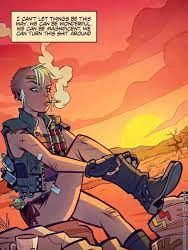
Source.
And yes, I know she's called "Tank Girl," and that modern-day dictator apologists are known as "tankies," but the point still stands.
***
Michelle Browne is a sci fi/fantasy writer and editor. She lives in Lethbridge, AB with her partner-in-crime and their cats. Her days revolve around freelance editing, knitting, jewelry, and learning too much. She is currently working on other people’s manuscripts, the next books in her series, and drinking as much tea as humanly possible.
Find her all over the internet: * OG Blog * Mailing list * Magpie Editing * Amazon * Medium * Twitter * Instagram * Facebook * Tumblr * Paypal.me * Ko-fi
1 note
·
View note
Text
General update
(long post warning)
Happy 2020!!
I, for one, am extremely happy to be in a new decade. Not much has been going on to explain my absence on this blog aside from just needing an artistic break. I’m still writing. Mostly fanfictions and knocking out a chapter here and there of The Colors of War or brainstorming a brand new idea. As for my last ‘announced’ wip (Libertie & Lizzie) the more I think about it the more I realize it was something I needed to start writing for myself as opposed to something I need to see be made a reality. It’s an idea from the past that I need to leave as a memory, which is why I think the pages never sat right with me. It started as a collaboration and I’ve lost touch with the other half. Perhaps another story will come out of the concept. Someday maybe.
While Libertie & Lizzie is being laid to rest, The Colors of War is coming together nicely. It’s a rough draft, but a much more final rough draft. As worried as I was about skipping from past to present tense and timeline, the more I write the more I feel it works. It might not for some, but I don’t have a great intention to traditionally publish anyway. We’ll see, I guess. If nothing else, there characters feel much stronger.
In my mental retreat, I’ve been reading a lot which, I admit, I’ve always underestimated the importance of as a writer. I’m grateful to have adapted a good routine which hasn’t been terribly interrupted when other obligations get in the way. Though non-fiction is my favorite medium, my head is spinning with ideas based on different events in history. I’ve also delved into the Chronicles of Narnia which has been a much different reading experience from science, history, classic literature (Does Narnia fall under this category?? I’m going to say no since it’s children’s fantasy.), and historical fiction. I’m enjoying it, though!
I’ve done a lot of soul searching over the past several months. I love writing. So much. But I was building up too high expectations from myself. Kudos to the authors that can dedicate every day to their story and then start another as soon as one finishes. I wish my brain worked this way. Unfortunately, as what has always happened, trying to change my approach to art has made me resent it. Writing will always be a great passion of mine (if not the greatest) but I don’t see it as my sole future. I don’t see myself as a full-time author and I don’t think I ever wanted to be. I’d rather spend a lifetime putting together one story and enjoy it than buy into the time-clock I’ve trained myself to adhere by having gotten my (main) start in NaNoWriMo. I love creating stories, and I want to stick to what I love about them. I don’t care if the day comes where people will read them start to finish or not.
Perhaps this is me nearing my quarter-life crisis. I don’t know. A lot has happened in the past year that has caused me to reevaluate my life. I don’t want to live in the bubble of a recluse writer anymore. That aspiration has damaged my social abilities. I want to travel and explore the world and capture it. I want to commit myself more to my faith which is the center of my life. I want to keep working and get to the point where I can handle a more sustainable job. I want to draw more. I want to let go of the past for once and for all and surround myself with loving and positive people.
I have a lot to look forward to this year. I attended BroadwayCon last week which is always a fun time (finally got to see Come From Away and won the lottery for Wicked!). I’m hoping the weather will allow an overnight trip to Quebec at the end of this month. I get to meet my dear friend @fairytale619 for the first time in May. In June I get to reunite with my darling @redgravewolfe and take a road trip halfway across the country and see states I’ve never visited. Hopefully somewhere in here I’ll manage a museum trip to Washington DC and another trip to Kennedy Space Center in Florida (which of course means Disney World as well). Other than this, I haven’t set any goals for this year other than to work toward getting out of the house more. I can’t write if I don’t live.
This isn’t a farewell to Tumblr post by any means. It’s more a typing things into the void at this point and trying to make sense of my own thoughts on what’s been going on. Superficially, the point of this post is to explain my absence and apologize for anybody I’ve inadvertently ignored. (Thank you to everyone who has continued to tag me in wip updates and tag games and to those who have sent messages saying hello!! I’m very grateful for your thoughts and for still including me!). I still want to post about my stories. I will try to make a greater effort in checking my dashboard and messages. I’ve missed the creative juices that get stirred looking at everyone’s work.
I hope you are all doing well! And if you’ve taken the time to read this ramble, my deepest thank you <3
6 notes
·
View notes
Text
Earth Day 2020 Visiting Artist
For Earth Day 2020, MCAD will be virtually hosting Christine Baeumler, a community-based artist focused on ecological restoration. An associate professor at the University of Minnesota in the Studio Arts department, Baeumler has worked on various green spaces within the Twin Cities and abroad, including the rooftop Tamarack Bog at MCAD! To join the Google Meet for the Visiting Artist lecture, use the following information:
Google Meet Room: Christine Baeumler Lecture
Link: https://meet.google.com/hfy-gxsp-swt
Phone, dial 601-935-4191
PIN: 220 663 421#
To lead into this talk, I asked Christine a couple of questions regarding both her work and the current global situation.
First of all, what are you currently working on?
Currently, I am focusing on the intergenerational as well as the interdisciplinary dimension of my collaborative practice. For example, in the Buzz Lab youth internship program at the Plains Art Museum and in the Backyard Phenology project, I am focused on appreciating how those projects can bring people from different backgrounds and age groups together. We all have so much to learn and gain from each other’s experiences.
You often work to improve urban green spaces. What are some examples of what you believe is a well done/designed green space? Any in the Twin Cities specifically?
I am most interested in urban green spaces that are not “designed” but intentionally create the conditions for increased habitat, biodiversity, and water quality considerations. This may mean managing plants introduced from elsewhere that thrive here to give the native plants a chance to re-establish, but also considering plants that are beneficial for pollinators and other species. These places may not appear designed to an outside observer, but a lot of labor goes into creating a thriving space. I acknowledge, however, it is not possible to fully restore our ecosystems given the damage humans have done to the land, water, and soil, at least in a short time frame.
Several places I particularly appreciate are the Quaking Bog at Theodore Wirth Park, (which inspired the Rooftop Bog at MCAD). It’s a tamarack bog with a walkway so that people can enjoy the bog but won’t disturb the delicate bog ecosystem there. The Bruce Vento Nature Sanctuary in St Paul below Iminija Ska (the White Cliffs) is an ongoing oak savanna restoration of a railroad brownfield, managed by the Parks and Recreation Department and the Lower Phalen Creek Project. If you haven’t been to either of those places I recommend a socially distanced walk (the walkway at the Quaking Bog is a bit narrow, so something to consider now).
I also appreciate the Native American Medicine Gardens on the University of Minnesota, Saint Paul Campus (across from the Bell Museum on Cleveland Avenue). The director of the Native American Medicine Garden, Cante Suta/ Francis Bettelyoun, has built up the soil (and the microbes) on the site over many years. Bettelyoun, students, and a team of volunteers care for the plants and animals there from the Indigenous perspective of Relatives. I love that among the neat rows of the experimental agricultural plots, the NAMG has an organic quality that is teeming with life--insects, birds, and mammals.
What aspects of urban living are you looking to change? How do you believe the integration of art and green spaces work to improve the living conditions within an urban environment?
As I mentioned before, in relation to the Native American Medicine Gardens, I believe that shifting our perspective as the natural world from resource to Relative, which is an Indigenous perspective, is such an important shift in awareness. I hope this shift in our consciousness can lead to different approaches about the ways we live, what we consume, as well as how we see our role as artists, designers and people with political agency.
I believe we have the opportunity to reconsider our roles as artists, and expand our notion of what is and what can be. I admire the practitioners of Maintenance Art, Mierle Laderman Ukeles and Sean Connaughty, whose artistic practice involves an everyday attention to dealing with waste (something most of us would choose to ignore).
This is another chance to think in terms of systems instead of discrete projects. We have big complex challenges, such as climate change, that need comprehensive and coordinated solutions. Individual choices matter, but we have to make systemic and political change on larger scales while keeping issues of environmental and social justice at the forefront of our consideration. Big topics, to be sure, but they require us to be attentive to ways things are interconnected. Maybe we can see how we are all connected more clearly at this time as we are all starting to feel our own vulnerability.
Artists and designers can integrate art and the urban environment by playing a variety of roles--but to me, working in interdisciplinary teams and with and in conversation with communities seems like an impactful way to collectively address environmental challenges.
As I watch environmental protections rolled back, for example, during this moment of Covid 19, I believe it is also incumbent upon us to act politically, to make our voices heard, and to vote in the fall.
We are in a time of great global change and uncertainty. How do you believe the quarantine and constantly shifting events will impact the art world, creatives, and our reactions to the world around us? Any advice for the students in quarantine?
I have so many questions instead of answers. First, how do we, as individuals and a community, consider those most deeply impacted by Covid 19? Those who do not have a home, food security or have health or economic challenges? How are we addressing more immediate needs? How do we effectively stand up to attempts to dismantle environmental protections or other moves that are destructive?
While we are reeling from the impact these changes make in our own lives, how do we stay present to what’s happening in the public sphere? I am asking these questions of myself and turning to those who have more advanced ideas and thinking about the present situation than I do.
The art world, consisting of cultural and educational institutions, organizations, community groups, funders and individuals have all been impacted in ways we are only beginning to comprehend. This may lead to a different way of organizing ourselves and our practices.
As I look out, I see a myriad of ways artists are approaching their work in this time of crises (plural because we face more than the pandemic) by creating platforms, opportunities, raising up voices, making the invisible visible, calling out injustice, creating awareness, and expressing a range of emotional responses through a variety of media --and offering work that provides solace and humor as well.
Historically, artists have always responded to crises and have been at the forefront of movements addressing injustice, violence, war, health crises, and environmental threats.
Now it is our turn, as artists, to consider how we respond. What a significant, and perhaps somewhat terrifying, opportunity. It may take us some time to collect ourselves. In fact, it seems important to take the time we need to adjust before we spring into action.
For students in quarantine.
I would encourage students to take this time to slow down, reflect, journal, meditate--whatever self reflective practices help you to be in touch with yourself--and take care of yourself. Embrace your feelings, and reach out if you need assistance. It’s ok not to be “productive” at this moment. We are in a time where people are experiencing extreme disruption and trauma--so be gentle with yourself. Connect to others in the ways you are able.. and don’t get too isolated.
Your voice, your ideas and your work are significant, and matter to the world. But being in touch with where you are in the moment may be the most important thing to honor.
Right now, many of us have the opportunity to slow down, reflect and more deeply examine our own lives and our relationship to what is important to our own well-being, our Fellow Beings and our Earth.
Any advice for how the individuals reading this can practice creativity, or any overall thoughts on the creative process in this time?
I want to offer a way to refresh our creativity. Take a break from technology. Go outside and connect with your “nature family,” the trees, the birds, the rocks, the sun, moon and stars. The weather. Using your imagination and the power of observation, quiet your mind and listen to what the world has to communicate with you. Have a conversation with a chipmunk, debate a crow, chuckle with a stone. The human world has become more quiet now, and perhaps it is our chance to engage, through our minds and our senses, with the world outside of our doors and beyond our screens.
-An Interview with Christine Baeumler, edited by Madilyn Duffy
2 notes
·
View notes
Text
Day 48, 7th Oct, Berlin
This morning I caught a bus around the corner from my hotel. I buy a day card each day, which costs about €7, and it lets you travel on any form of transport all over the city, so great value. Bus 265 took me to where I was going. This bus continues on to Tempelhof Park which is where the huge impressive Russian Memorial is located but I didn’t have time to revisit that today. On the street I came across some more ‘stumbling stones’. These people died in Auschwitz and Chelmno.
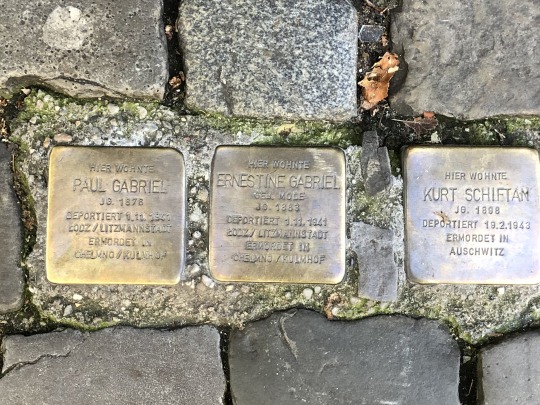
This was the building the stones were in front of. The stones are a real reminder of what happened on this spot during the war.

I was in this location as I wanted to see this particular street art painted by the identical Brazilian twins Otavio and Gustavo Pandolfo who are best known for their large-scale installations and murals depicting strangely dressed and unusually proportioned, yellow-skinned figures. Influenced primarily by their upbringing in São Paolo, they first started developing their recognizable style at the age of twelve. I have now seen their work in Łódź, Vilnius, Lisbon, Vancouver and now Berlin.

The U Bahn also rans through this area up on raised lines. I was on my way to the East Side Gallery across the river after seeing the painting.

The Oberbeurn Bridge which is considered one of the most attractive bridges in Germany. The towers were badly damaged in the war. The bridge was one of the dividing lines between east and west. The bridge in East territory.
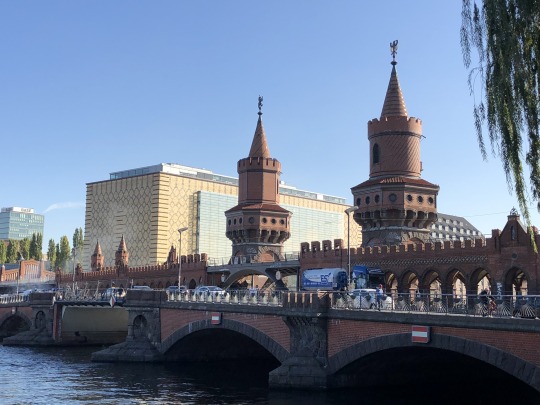
The river was in East Berlin, as well.
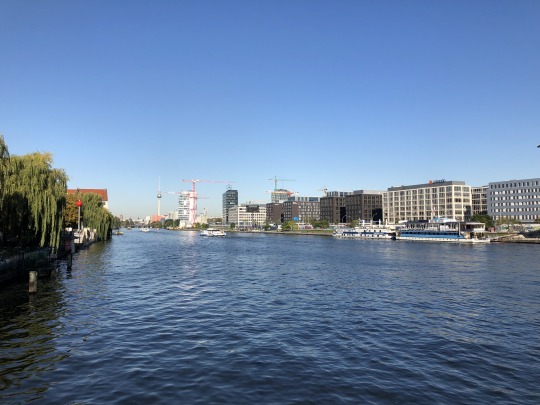
The East West Gallery runs along the river in this area. The birth of Berlin’s street art scene can be traced back to 1961 when the Soviet Union erected the Berlin wall, separating East Germany from West Germany. Due to the symbolic significance of the wall as a divisive medium, it became the obvious place for the citizens of Berlin to express their opinions and frustrations on a whole range of issues. On the other hand, it was also seen as an exceptionally unattractive eyesore that the people of Berlin felt compelled to do something about. During the Cold War, the West side of the Berlin wall was completely covered in painting, unlike the East side of the wall which remained blank, because people in East Berlin were unable to get close enough to the wall to paint on it. Interestingly, since the wall fell in 1989, a lot of new art was added to the East side of wall in the 1990’s, allowing viewers to trace the historical and political change that occurred in Europe by comparing and contrasting the different themes depicted on either side of the wall.

The paintings seemed a bit different to when I was here before. I know there has been some work done to preserve the almost 30 year old paintings in some cases but there looked to be new ones and not all about the wall.

This one is probably the most iconic. It has definitely been given a facelift. It’s of Breszhnev kissing Honecker.

Some that I remembered from last time were a bit hard to see as there was a new building going up and boards were in place along part of the wall.
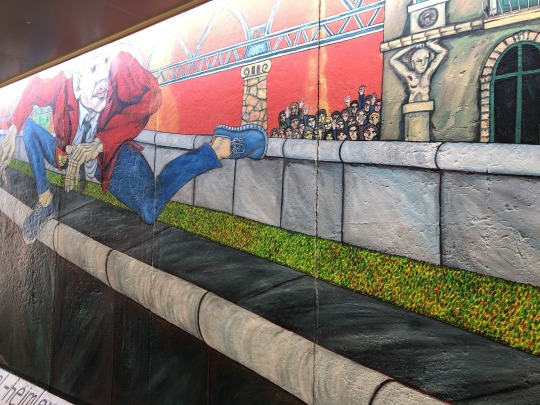
Mercedes Benz dominates the city a bit. The company brings in a lot of money as well as owning a lot if real estate. The areana is across the road from the Gallery.

New work like this one was about Amestry International.

From the Gallery I caught a U Bahn then the No. 100 bus that goes from Alexander Platz up the main strip to the Brandenburg Gate. The statues on the River Spree.
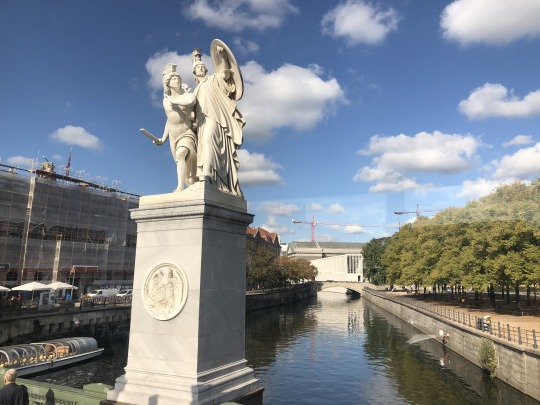
One of the Museums in this area.
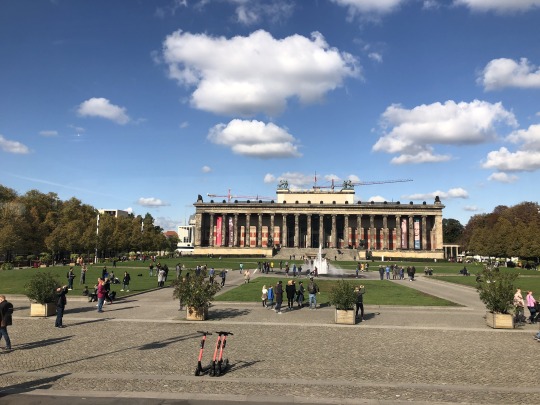
The Dom.
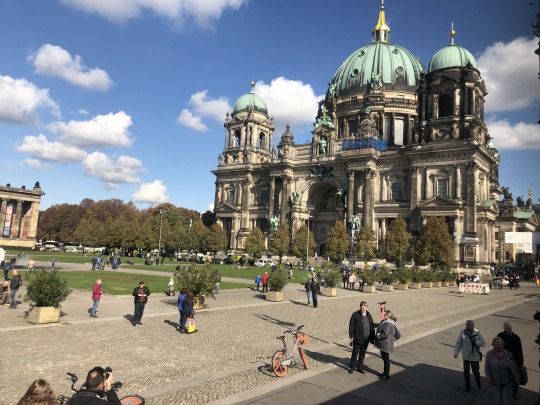
The University.
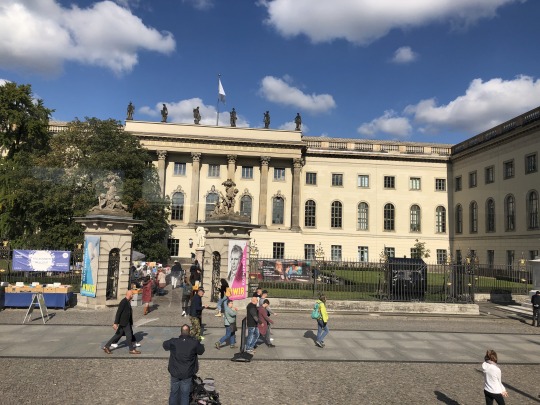
The Brandenburg Gate.

Very close to the Brandenburg Gate is the Jewish Memorial.

It’s just all grey blocks of different heights and sizes on undulating land. Very unique.
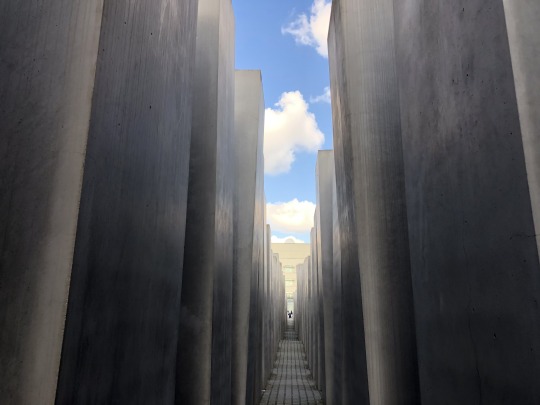
From the Memorial I walked to the Sony Centre at Potsdam Platz. I had never seen it close up.

Quite spectacular the space inside.
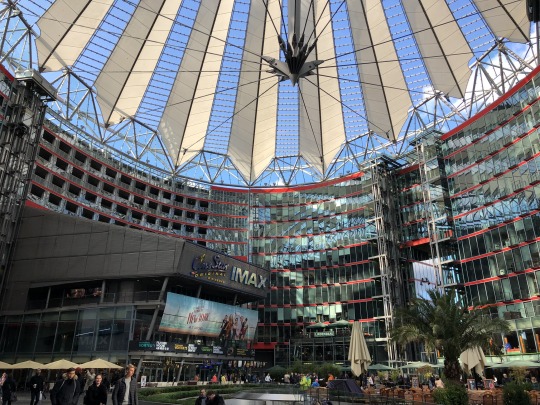
The roof is amazing. I spent a bit of time in here.
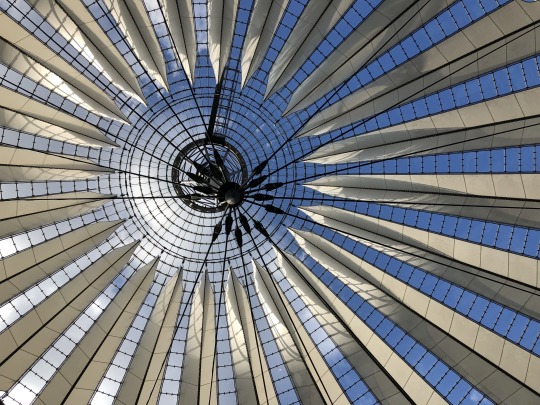
Back on the streets a climate change demonstration was going on. All very peaceful.

Mostly young people there with a big police presence.

All over Berlin you come across information boards about some historical event in the past. The Germans don’t hide their history.
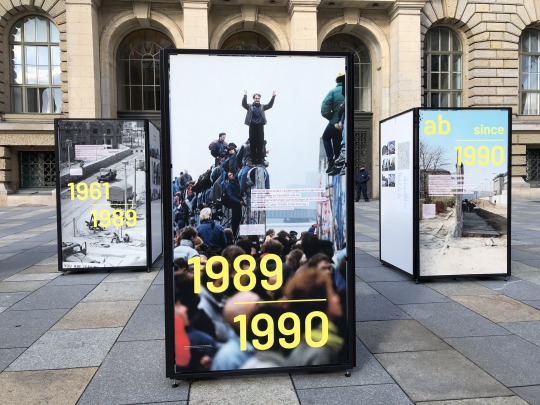
These cars where used extensively in East Berlin and are now a novelty. You can hire them for a ride around the city.

This is part of the wall at the Topography of Terror.
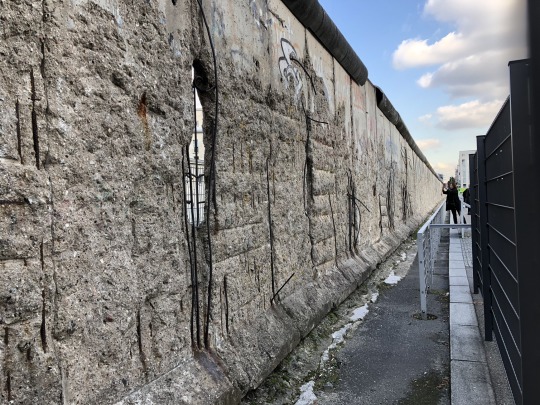
The ballon was taking people up high for a birds eye view.

Wherever the Wall was in Berlin it is now indicated by stone work and bronze plaques.
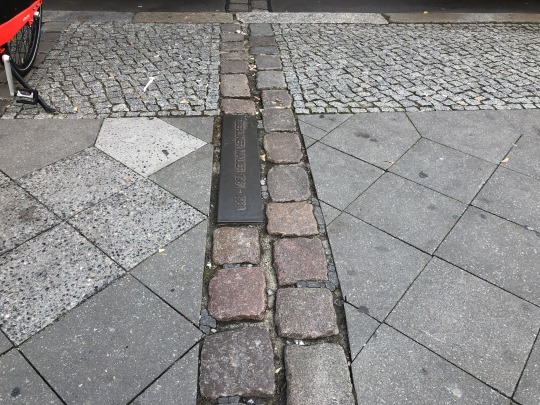
Checkpoint Charlie.
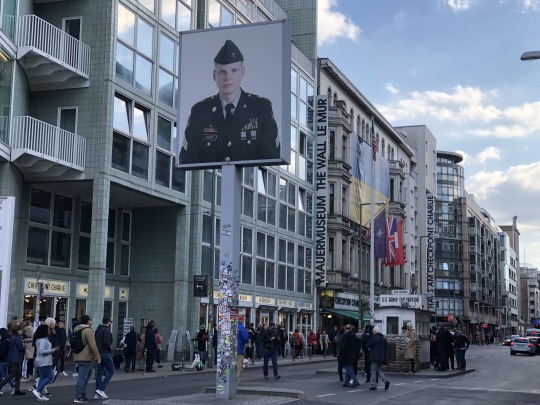
I took the opportunity to have my photo taken. Usually there are people dressed in Us and Russian uniforms you pay to have your photo with. Maybe they have stopped that.
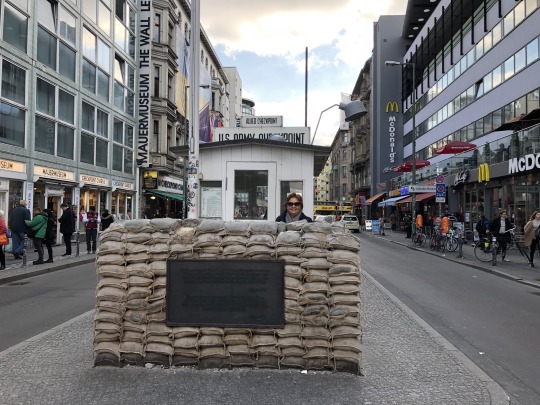
This is the way it looked in the day. A very tense location.
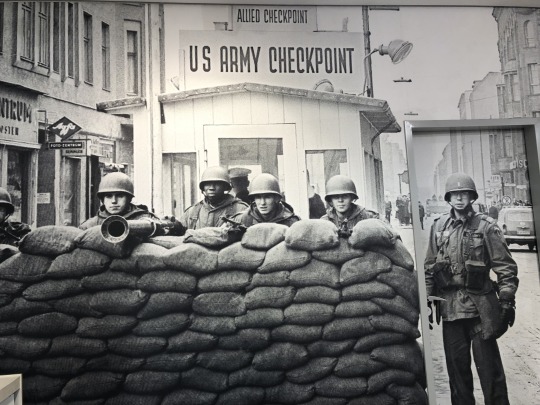
The sign at Checkpoint Charlie.

This girl had an interesting tale. I came across her putting down a row of dirt and a row of seeds. It symbolises the joining together and growth that comes when things combine. Eg seeds and dirt. She is an artist and tries to do 9 each day. I can’t remember how many she wants to do all up but it’s between her parents home and the refugee camp they were in when they arrived in Berlin from Russia. She was 9 when they came in 1995. She told all about her family and that she doesn’t know whether she feels a Russian or German. A common issue for many new migrants. It’s amazing what you come across walking the streets.

I finally made it to the Jewish Museum. I have never been there before. The front of the Museum is very different from the newer building that houses most of the exhibits.
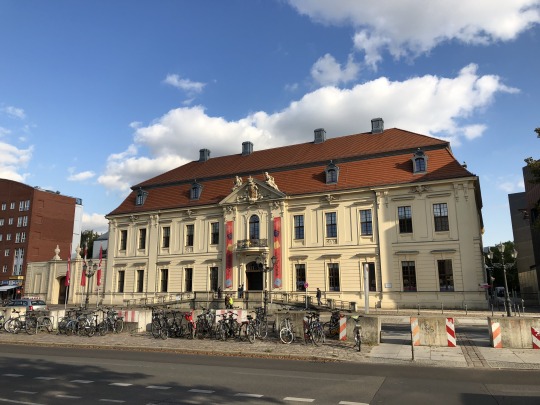
The Halocaust Tower.

Slanting walls, sharp angles, gaping voids. The architecture creates its own symbolic language for the history of the Jews in Germany. The Axis of the Halocaust and The Axis of Exile portray the persecution and murder of Jews during the Nazi era, as well as the escape from Germany into exile.

The Garden of Exile is made up of 49 concrete slabs positioned on sloping ground. The trees growing on top are a symbol of hope.

The Memory Void is dedicated to the victims of war. 10,000 heavy iron plates are cut to resemble faces. You can walk on the faces and they give off a clanging sound which is a bit chilling.

The grey futuristic look of the new building which houses most of the museum.
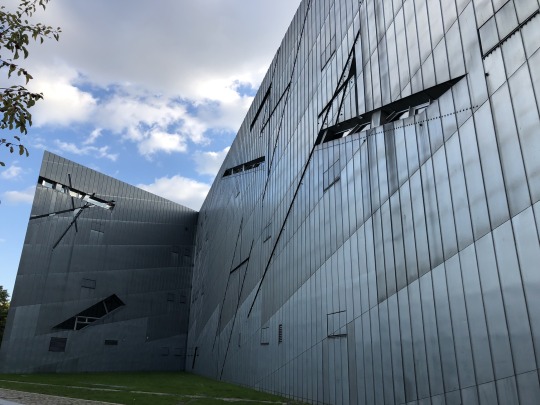
A lighter exhibition of photographs from the West Bank of Isreal was also in the museum.
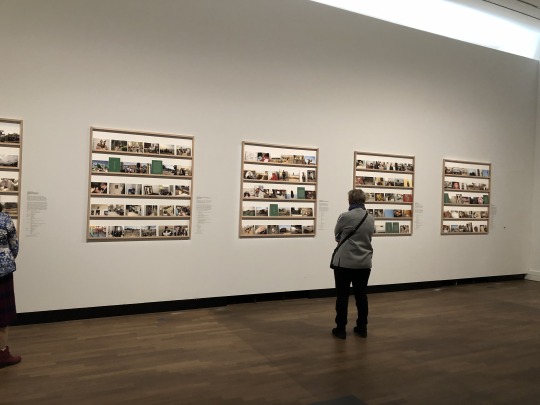
Some great photos.
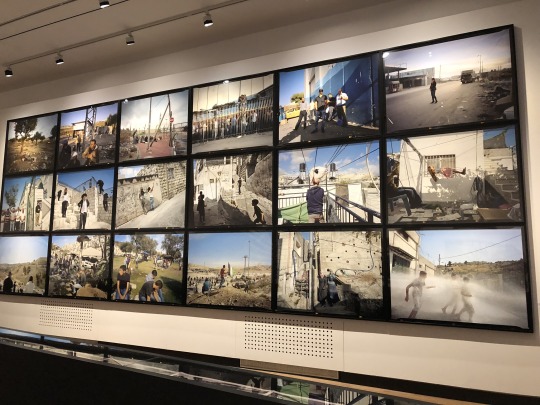
The lights in the cafe had Hebrew written inside which made a great pattern with its reflection.

From the museum I could catch the No 248 bus back to the hotel but I went further to Alexander Platz for another look around and then the bus back. Another long interesting day. Heading north again tomorrow on the train.
6 notes
·
View notes
Text
Alexander Rambleblay (Sonic OC)
Name: Alexander Rambleblay
Nickname(s): Alex, Ramble
Job: (Unsuccessful) writer of pseudo-archaeological books and articles, pseudo-Archaeologist
Gender: male
Age: 46
Species: Human
Family: Sister, Brother
Relationship: Single
Misc:
He claims to have a Doctor and Professor in History which is actually a lie, same goes for his claim to won prizes
Accessed and dug on property without authorization.
His income comes mostly from donation, writing articles for pseudoscientific magazines, tabloids or dime novels (the latter often influenced by his pseudo-archaeological believes who people believe to be science-fiction.
Despite his often financial dim looking situation he’s clothed quite fancy
Speaking about finances, he’s often supported by his siblings (Alex is the youngest from two other siblings)
In his family he’s considered the ���black sheep” due of the lawsuits he gathered over time.
It happens from time to time that the monocle he wears falls down (luckily for him it’s attached on a copper chain)
Appearance:
Due of constant outside “research trips for Archaeological purposes” (whenever his free time allows) Rambleblays skin color got a strong tan, to prevent sunburn he wears as a form of protection a straw hat. His physical high is around 1,63 meters and he weighs 58 kilograms. The hair color of Alexander is dirty blonde, they’re shoulder long and mostly straight. The eyes have an indigo dye color, on the left side he wears a monocle in a copper colored frame. Alexanders facial hair has the same color as the one on his head, it’s grown to a bushy full beard covering everything around the mouth till the chin.
Alexander prefers to wear a white shirt with short sleeves together with a bow tie and suspenders are kept in emerald green. The trousers are made with a grape purple fabric, on the right and left side of the trousers are stripes in the same green color like the bow tie and suspenders.
His shoes are kept in a cocoa brown color with black ties and beige soles.
Alexander prefers to wield a cane, which he does not need actually but uses either way as a tool or make-shift weapon.
During rain or winter he prefers to wear over his casual clothing a forest green trench coat together with a same colored homburg hat that’s decorated with a thistle colored band around the hat.
Formal he wears a simple black tie dress code.
Personality:
The first three words that come into someone's mind if they know Alexander Rambleblay is self-centered, arrogant and know it all. The self declared “Ace-Archaeologist” wants that everyone plays by his rules when it comes to excavations, even if it means to destroy evidence him theories might be in the wrong or altering them. Alexander enjoys to be in the middle of attention, he will try under all circumstances to keep up his reputation, even if it means to denounce your opponent and spreading lies and rumors about them.
Speaking of Lying, Alexander is quite good in spreading lies about himself, those who make him appear in a good light only of course. Whenever it’s that he got a prize or an honorary title, might it even be as exaggerated as possible, there are people who believe him. Together with what some people would claim as “charm” it gives an interesting mixture but dangerous to those who stand in his way.
Despite his selfish attitude Rambleblay is quite intelligent, especially when it comes to manipulate people, or artifacts. The human can’t stand critic or doubt in his works and calls everyone outdated or ignorant who tries to prove him otherwise or even have solid prove that his historic theories are false or got dis proven a long time ago.
Speaking about his manipulation skills, since it was mentioned that he is ruthless about destroying or editing archeological evidence, the same applies for using false business cards that make him appear to be a Doctor, Professor or having a master degree.
When out of words that could back him up he changes to private topics that he tries to use against his opponents, may they be in private or due scientific meetings. Alexander can be very focused and has a good long and short therm memory. Although good in entangling critics in words and meaningless discussions Rambleblay prefers to keep them short so he can focus on something else, but it’s also said that he can go on long rants from time to time, where he isn’t scared to call for a judicial hearing to see who is in the right.
Most of his time when he’s not doing (illegal) diggings and or research he either way reads books, writes or gives interviews. Although he believes in his own pseudo-archaeological theories he does not mind to read the one or other article from true archeological or science magazines, might it only be for the reasons to “re-use” some parts for his own works or to look for new places to dig.
Given his liking for attention he sometimes likes to invite himself to seminars or archaeologic conventions, where once again he has discussions and arguments with other people who often turn into (verbal) fights, another reason why many people in archeological fields see in him not only not a real researcher, a nut job but also a troublemaker.
Whilst being banned from at least 20 campuses and as much conventions Alexander holds a grand reputation on the internet, especially social media and video sharing websites. Whilst not having an own channel on the latter many people upload his discussions and talk about his books or other scientific papers and review them, positively for him often in a good light. (Of course there are critics but even his lawyer is powerless against those who reject him, all he can do is painfully ignore them)
Skills/Strengths:
Writing
Cogency
Manipulation
Archiving
High Vocabulary
Weaknesses/Limitations:
Hot headed
Arrogant
Egocentric
Easily Offended
Know it all
History:
Born in Station Square Alexander grew up as the youngest of three children, growing up in a middle class family, with a father as headmaster of a middle school and his mother being a primary school teacher. Early in his live the young Rambleblay took an interest in history but also reading and writing science fiction. Whilst first intended to graduate in a school for arts he later changed his mind and went to a place that educated more about ancient history.
Whilst he finished University with a Bachelor with praise he never finished his Master due of him voluntary ceasing his activity there. He worked for some time due of his dissatisfaction of what was taught. In Alex theory such grand buildings like temples or pyramids could have not been done by some ancient or primitive civilizations like school used to taught but rather that they went into the wrong directions due of according to his own words “using outdated data”, researching on his own for a long time the Bachelors theory became more and more clear to him.
Ancient civilizations where only pretending to be ancients, actually they had been god like, able to uses modern weapons and technology the society he lived in could only dream off, but those technologies where a well kept secret thus the “real primitive” tribes would not find out about their “technological superiority. According to Alex believe either way due of a forgotten event these civilizations laid down their technological ways and with times the technology got forgotten, or that due of a war they hid down in a vault deep down into the planets where they now live, given that they do not seek to disturb nor help the People that live now on the outer shell of the planet. That extraterrestrial live or godlike creatures might have their hands in this is something Alex does not rule out. Due of this and many other crazy theories many colleagues or supervisors who worked with him together in delight now turned their backs on him, claiming to have lost a good friend to mad theories.
It got even more damaged when discovered that not only was he hiding or stealing sometimes excavated objects of interests and keep them for himself, but also that he also claimed them to be of different purpose, altered or even destroyed them.
Thrown out by historical and archaeological societies Alexander began to form his own circle of believers and theorists who supported him. With the help of some more influencing pseudo scientists and archaeologists he was able to pull some lawsuits and to become famous on social media, securing his status and making some of his critics silent. Still in a quite a financial trouble he went to his siblings who lent him money (much to their and their families displeasure)
Having built up new reputation the self declared “modern archaeologist” began to hold more seminars, interviews in (pseudo)scientific papers and writing his own books. With the help of the donations he was able to pay for the remaining costs of his lawsuits and pay for advertisements on the internet, making him more popular and (in)famous than he ever was before.
Alexander Rambleblay attempts to get government funding and approval for an own excavation on well known ruins, believing it to be the capital of the “Ancient people” and digging in what he believes to be a gigantic chamber full of treasure and ancient powerful technology way superior than current ones. Archaeologists and Historians alike try with all power they have to stop him due of the theory that it actually might be a gigantic natural methane gas that might cause of either way to blow up the whole place or make it sink in.
Currently he’s writing on his seventh book and tries to get support for a side project that whilst not much is known about appears to involve the ancient flying islands and their underground ruins where he assumes another outpost of the “ancient us superior civilization that just awaits to be awoken, that might even be from another planet!” Needless to say he’s already started an online donation for this new fraud scientific adventure with lots of secret technology, conspiracy, mystery and especially irrefutable stuff. (According to his latest article in a magazine)
#Sth#Sonic#OC#OC of others#Alexander Rambleblay#Writing#Writing from me#fanfic#Fanfiction#Sonic the Hedgehog
4 notes
·
View notes
Text
Major Arcana Cheat Sheet
The Fool: The Fool is a very powerful card in the Tarot deck, usually representing a new beginning -- and, consequently, an end to something in your old life. The Fool's position in your spread reveals which aspects of your life may be subject to change. The Fool portends important decisions ahead which may not be easy to make, and involve an element of risk for you. Approach the changes with optimism and care to gain the most positive outcome.
The Magician: The Magician generally associates with intelligent and skillful communicators. His presence in your spread indicates a level of self-confidence and drive which allows you to translate ideas into action. A practical card, the revelations it brings are best applied to the pragmatic and physical aspects of your life, rather then the ephemeral or theoretical. Your success in upcoming ventures in politics or business will likely hinge upon your own strength of will and determination.
The High Priestess: Your identification with the High Priestess suggests you possess inherent good judgment, in the form of strong intuition. She may indicate that reason should take second place to instinct. Your head must trust in the wisdom of your heart for a change. Yet, she is also an aide by nature, and her presence in certain parts of your spread could be indicative of someone close to you coming to your rescue with their own intuition. Intuition is most effective at seeing what is hidden to the senses, so the High Priestess may also come as a warning of concealed facts or influences that are, or will be, important to you.
The Empress: Traditionally associated with strong maternal influence, the presence of the Empress is excellent news if you are looking for harmony in your marriage or hoping to start a family. Any artistic endeavors you are currently associated with are also likely to be more successful, as this card often finds those exposed to strong bursts of creative or artistic energy. That creative energy may not be in the form of a painting or art project, however: This card also suggests a very strong possibility of pregnancy -- not necessarily yours, but you might be seeing a new addition to your extended family or the family of a close friend in the near future! This card is a good portent for you and those around you.
The Emperor: Counterpart to the Empress, the Emperor is signifies a powerful influence, generally male in nature. This can also include concepts in your life historically considered masculine, such as leadership and authority, self-discipline, and stability through the power of action. Its positive influences suggest you may be on a path to advancement or promotion, but it can also be neutral. Often a companion to those destined to take on greater responsibility, it may presage change or loss that necessitates you stepping forward to shoulder a greater burden than you have in the past. Whatever the impetus for the change, it indicates you may possess an uncommon inner strength that will compel you act and to lead.
The Hierophant (Pope): Depending on your own nature, the Hierophant can mean very different things. At its root, it represents doctrine, but doctrine can come in the form of teaching and guidance or rigid authority. Where it appears in your spread is also important, as it is most often indicative of your own approach to the moral, religious, and social conventions of the world. Considered wisely, it helps show the path towards fulfillment.
The Lovers: Your first instinct will most likely be to associate this card as representing love, but, much like love, it does not possess a simple nature. Not only does love comes in many forms, but the Lovers may indicate important or difficult choices ahead in your life. This is bad, in that the choices it portends are generally mutually exclusive, paths to two very different futures, but also good, in that it also confirms that at least one of those paths will take you to a good place. As such, if you happen to find it in your spread, you should consider it carefully, but not fear it. It tells a story of difficult choices, likely painful, but that the correct decision and a positive outcome are within your grasp.
The Chariot: You have some hard work ahead of you. It may be resolved quickly, but the Chariot is a powerful card, and the labor you are undertaking will probably trend towards long and difficult. You will quite possibly experience rough roads, long uphill slopes, dead ends, and painful setbacks. A good outcome is only assured if the card is upright, but do not let yourself lose hope: This hard road will instill in you a strength of purpose, the ability to overcome through organization and endurance, and the confidence possessed only by those who have done what they thought they could not. Harnessed correctly, few forces can stand against an individual like that.
Strength: Strength is the rawest form of power, and you possess it in some form. It is a very happy card if you are fighting illness or recovering from injury. As might be suspected, its influence over you, and the use you put it to, can trend towards light or dark. You likely trend towards facing your problems courageously, head-on, and conquering them through perseverance and will. With this ability to overcome life's obstacles, though, comes the responsibility to control yourself, and it this card may be a warning to take command of your own actions or emotions before they damage you or the people you care about.
The Hermit: There are times in every life, when one must step back and make a careful examination of their situations and decisions. Finding the Hermit in your spread suggests this is just such a time for you. You are in need of a period of inner reflection, away from the current demands of your position. This retreat can be physical, or a search within. Only a deep and honest introspection will lead to a solution, however.
Wheel of Fortune: Symbolic of life's cycles, the Wheel of Fortune speaks to good beginnings. Most likely, you will find the events foretold to be positive, but, being aspects of luck, they may also be beyond your control and influence. Tend those things you can control with care, and learn not to agonize over the ones you cannot.
Justice: Justice is a very good card to find in your spread if you have acted with kindness and fairness towards other and, especially, if you have been a victim. It is a significant indicator of a positive resolution, although how and what sort will depend on your own experiences. If you have been unfair, abusive, or otherwise shady and immoral in your dealings, though, pay heed. For the unjust, this card is, at best, a dire warning to change your ways before retribution falls upon you, and, at worst, a simple statement that it is already too late. In neutral cases, it may simply be telling you to seek out balance in your life.
The Hanged Man: The Hanged Man can be interpreted in two very different ways. All change is a small kind of death, as the old must die to create the new, and it may simply indicate upheaval or change in your future, perhaps beyond your control, but more likely a decision that, for good or ill, you will not be able to turn back from. The other interpretation is one of sacrifice, although whether this sacrifice is small or great may not be easily interpreted. Both interpretations imply permanence, and that you should give very careful thought to the decisions in your life.
Death: Death is indicative of change in your future. This change can be in almost any aspect of your life, but it will almost certainly be permanent, significant, and absolute. Death suggests a complete severance between the past and the future, and it will likely be painful. Despite the sense of loss that may accompany it, Death fills an important and natural role in life, and leads eventually to acceptance. It is a necessary part of moving forward, and you will find the changes easiest if you embrace them, rather than fight them. Expect the end of a close friendship, a job, a marriage, or even a life, but do not focus too greatly on the negative.
Temperance: An optimistic card, Temperance encourages you to find balance in your life and approach problems with a calm demeanor. It recognizes that opposing forces need not be at war within you. Tread carefully in any major decisions you make, with confidence that good decisions will lead to a good resolution for you.
The Devil: The Devil is in the business of entrapment. It signifies a situation from which there is no escape, or a road leading to one. Forewarning may let you avoid the trap, or it may not. What sort of trap, and how you might avoid it, depends on where the Devil appears in your spread, and what other cards surround it. This card does not foretell doom, only the need for prudence.
The Tower: Dark and foreboding, the Tower is the embodiment of disruption and conflict. Not just change, but the abrupt and jarring movement caused by the unforeseen and traumatic events which are part of life. The Tower in your spread is always a threat, but life inevitably involves tragedy, and you must decide whether you will face it with grace.
The Star: The Star's presence signifies a period of respite and renewal for you. This renewal may be spiritual, physical, or both. It is a particularly positive sign if you or someone close is recovering from illness or injury. It is a light in the darkness, illuminating your future and your past.
The Moon: Something in your life is not what it seems. Perhaps a misunderstanding on your part, or a truth you cannot admit to yourself. It may also indicate something important being kept from you by another. This may be a source of worry or depression in your life, and the Moon is a strong indicator that you must rely on your intuition to see through the subterfuge.
The Sun: As an inherently good influence, finding the Sun is a positive development. It is suggestive of personal gain, and that personal goals and joy are within reach, if you are willing to invest the effort to actualize them. If you are embarking on a new personal venture, such as marriage or beginning a family, the Sun is of particular influence.
Judgement: Judgment tells a story of transition, but unlike Death or the Tower, it is not sudden change, or born of luck or intuition, but change that springs from reason. It signifies plans, often long in the making, coming to fruition. If it points towards the future, it may also speak towards the nature of the change; if there is a choice that needs to be made, ruminate and let your mind guide the decision. Logic, in this case, is a better guide than intuition. Be prepared to make a major decision in your life, likely one that will shape the next chapter of your life.
The World: The World is an indicator of a major and inexorable change, of tectonic breadth. This change represents a chance for you to bring about a desirable end to the Old and a good beginning to the New. It is indicative of growing maturity, a sense of inner balance and deeper understanding. It suggests that you may be approaching a more final sense of identity, and the security in the self that comes with age. It also represents the falling away of boundaries, sometimes in the effusive sense of the spiritual, but sometimes in a purely physical sense, indicating travels or journeys in the future.
#witchcraft#tarot#magic#witches#winter#witch#witchy#tarot tips#major arcana#arcana#tarot cards#witch tip#baby witch#beginner witch#beginning witch#beginner witch spell
11K notes
·
View notes
Text
Dragons
The Drakan race, colloquially known as dragons, are an ancient and varied species that predates our own by several hundred thousand years. The first known intelligent life on the planet, they were the dominant life forms up until the emergence of human civilization around 15,000 years ago.
Accounts from this time are few and far-between outside of Drakan sources, but according to these sources, the dragons initially tried to coexist peacefully with homo sapiens. Unfortunately, it was not to be. Learning magic by observing the dragons, humans used their own art against them and began driving them out of their cities and territories, claiming their land for our own.
Though we have existed in conflict longer than we’ve coexisted, today, in a post-war world, tensions between humans and dragons are at an all-time low. They live among us in our cities and have largely come out of hiding in an attempt to undo the damage done by D’aagor and to bridge the gap between us. But there remains a long history of violence and genocide that cannot be ignored.
Because of this history, most dragons are still wary of humans, even while living alongside us - and rightfully so. While they are considered a fringe minority, there still exist radical groups who are staunchly ‘pro-human’, and by extension, anti-dragon, practicing acts of violence and terrorism against our sibling species. Similarly, there remain dragons who believe D’aagor was right that we cannot be trusted, and who think our two species should remain separated or who would like to visit some of the pain we inflicted on them in their past on us.
Though the situation appears stable on the surface, events like the Morning Star Massacre serve as a constant reminder that there is still a lot of hate between us and that a utopian society where dragons and humans live together in harmony is still not yet within our grasp. Though great strides have been made, there is still work to be done.
As a species, dragons did not evolve from dinosaurs, but rather from other proto-reptiles sometime during the late Triassic Period. As they have existed longer than us, they are also more advanced than us. However, while we humans rely heavily on our cleverness and our use of tools and technology to survive, the dragons have managed to get by primarily by using magic.
Though they are not technologically inept, and they have some surprisingly advanced scientific knowledge, dragons are the progenitors of all known magical art forms, and are more inclined to the magical arts than humans by nature. Though some ancient accounts of the Drakan people seem to indicate that this may be a manufactured trait, or at least one they expanded on artificially at some point in their species’ past.
Dragons can survive in a wide array of different climates, and are capable of tolerating extremes in temperature and habitat far beyond what any human could withstand. They can be found living anywhere from the bowels of volcanoes to the frozen tundras of the antarctic, managing a comfortable existence even when food or resources are seemingly scarce by way of their magic.
If their claims are to be believed, the Drakan people did a good deal of genetic engineering to their benefit in the past, and the result of this is that they are a more hardy species than they perhaps otherwise would’ve been. And, for whatever they cannot tolerate, they have their magic to fall back on to protect or support them.
Dragons are also a social species, much like humans, and rarely live alone. Wherever you find one dragon, you will likely find more, and families tend to share the same nest across multiple generations. In fact, it’s actually somewhat rare for a dragon to move out of its family nest and into one that belongs to them alone, outside of mates, who are given the option to share nests or to leave and start their own. These days, many dragons elect to share one nest, but this is gradually beginning to change - especially for dragons who have chosen to live in human cities.
Perhaps the most notable thing about dragons, however, is the wide variety of shapes and sizes that they come in. While some of it can be chalked up to adaption and evolution, DNA analysis indicates that while all dragons share enough genetic material now to reproduce with one another without issue regardless of race, these multiple different races may actually be more closely approximated to subspecies. And for some of them, it would appear that their evolutionary ancestors are completely separate entities.
Dragons, then, are a more varied species, genetically speaking, than humans. Because of this, the differences between them can be more than superficial. But, they seem to be better off for this. They are highly adaptable and continue to evolve to this day, just as we do, though in the case of the dragons, this evolution may be more directed by their own hand than nature’s.
Some dragons today even have a sizable chunk of human DNA in their genome, sizable enough that they are able to not only freely shapeshift into us, but reproduce with us, resulting in halflings - an entirely new species distinct from both humans and dragons, but capable of intermingling with either and transforming into either - be it partially or completely - at will.
This human DNA was artificially inserted into their genome fairly recently - during sometime in the late middle ages - in order to help them better blend in among humans and escape persecution. Dragons with this human DNA in their genome are known as ‘Shifters’, and comprise about 40% of all modern day dragons. They are considered to be a new, separate race within the Drakan species, but one which can have the defining traits of any of the other 9 known races.
The current King of Dragons, Sirus Albion, monarch of the Aldarian Empire (the last known Drakan superpower), is a Shifter, and an outspoken proponent for the rights of Shifters within Drakan communities. Until fairly recently, Shifters were seen as traitors to the species, and while they were not met with violence, the opinion of Shifters has historically been rather poor, and they have been treated by purebloods as second-class citizens. This began to change sometime around the mid 1800′s, however, and today, they are seen as being just as dragon as any other race within their rather expansive species.
The lifespan of a dragon greatly dwarfs that of a human, with the oldest known dragons having lived to be over 2500 years old. This upper age limit appears to be universal across all their races, and taking all 10 into account, lifespans tend to average out at around 1800 years. Because of this, dragon culture is remarkably slow to change from a human perspective, while from a dragon’s perspective, human culture moves at a breakneck pace. This has only served to complicate matters when it comes to coexistence.
As far as magic is concerned, all dragons have ‘mana pools’ far greater than that of all but the most extraordinary human mages, but as a trade off, most dragons are limited to magic that is confined to a singular ‘element’. There are 5 basic elements - Earth, Air, Fire, Water, and Lightning - but some dragons have elements unique to them or their bloodlines, including the likes of Smoke or Magma. What these elements boil down to is ultimately a limitation on the kind of magic a dragon can freely perform.
The most common magic a dragon can use is called ‘breath magic’, and would be consist of the likes of breathing fire or causing earthquakes with their cries. Though magic can be performed that doesn’t belong to any of the elements, as compared to human mages, dragons have a more difficult time performing these. So typically, dragons require more time, focus, and mana to perform something like a teleportation spell or to create a non-elemental energy construct than a human would.
To help get around this, most dragons try to work these spells into their elements somehow - such as a teleportation spell that allows them to warp around through fire or water-covered surfaces - to enhance utility. But they can also create spells that they can program into crystals colloquially referred to as Draconite.
Draconite is any gem or crystal used by the dragons to perform magic. They serve a wide variety of uses and can come in a wide variety of types, shapes, and sizes, just like the dragons themselves. They can be common quartz or rare precious stones. By manipulating their internal structures with their mana, they are able to turn crystals and gems into magical circuits that can memorize and instant cast any spell programmed into it. Each gem or crystal can only know and perform one spell, but will have a much easier time with it than a dragon and will cast it at no cost to a dragon’s mana.
Most dragon cities rely heavily on draconite to exist, with the Kingdom of Aldaron, capital city of the dragons, using it to keep a good chunk of its structures floating in the sky above as opposed to on or in the ground. Draconite also doesn’t need any external magical input to cast their spells, unless they are specifically programmed to work that way. Instead, most gems and crystals are constantly casting some permanent or passive effect that is self-sustained by energy generated by the gems or crystals themselves.
This energy is not infinite, however, and eventually, it will run out. When this happens, a new draconite gem or crystal will have to be introduced to continue the effect, much like changing the battery in a piece of technology.
9 notes
·
View notes
Text
Research Report
Pilot Project Title: “Rebel Girls”
Name: Patrycja Borecka
Research Methods:
As an activist I wanted to make a project related to current affairs. I basically started absorbing all related information which I came across or found through my research: -photography - going to exhibitions, reading recently published books and magazines, doing my own practice, try to understand medium more
-sociological - listening to the radio programs and podcasting, talking to people, internet research about struggles which people have it nowadays,
-Political - following the news, try to understand the relation between the countries,
-technological - learning about new radical technologies and how they can be used and what impact they have on human beings and planet.
All four bullet points above are connected together.
As an active photography practitioner I often go on the streets to document protests in London. As this was not enough, I challenge myself to interview demonstrators, record them, write narrative to the event and ask for a portrait in fast paced location. At the beginning I found conducting interviews quiet uncomfortable, but with time I realised that it makes me closer to demonstration in terms of understanding other people’s views and ways of thinking about political issues. This experience taught me new interpersonal skills.
I went to see unauthorised exhibition, “Temporary Autonomous Art” in Lewisham, the event took place in an abandoned building which currently is occupied by squatters, the local authorities are aware of occupation but do not really bother to take any actions as developers did not spot yet the opportunity to build more “affordable” flats.
The exhibition was enormous ( three floors in large warehouse, over sixty artists) and I did not see all things. However the work of artists was pretty much underground, against the system and capitalism. It did represented the oppressions, global issues and beauty of socialising with other humans. I have an opportunity to talk to artists and hear their stories. The exhibition highlighted the need of creating the art not the need of making a profit through the art.
Another exhibition was in Foyless (bookshop in central London). It was one floor display next to the fancy coffee place and it was connected to a new “historical” book publication, Peter Kennard: Visual Dissent. Peter Kennard is an unofficial war artist, I came across his name while I was following news about Arms Fair 2019 in London. I found his work very close to my own values, on Instagram I saw the new book release and I went to see the exhibition. His photo collages and forty years of art work did pay back in changes of political regulations. He is a big inspiration to me. The Visual Dissent book taught me more about rising up and strikes in the past, it made me visit the National Gallery and painting which inspired Kennard to make art. I also attended a talk with Peter and went to visit him in his studio. We spoke about politics, China, art, money and Augmented Reality. He introduced me to the name Hito Steyerl, who was having an exhibition at Serpentine Sackler Gallery in Hyde Park. It was augmented reality exhibition called Actual Reality.
Steyerl’s work maybe visually was not as impressive as Kennard’s photomontages but the subject which she chose to interrogate was very interesting: inequality, workers rights, wealth and housing crisis. This made me think that however I will try to display my work it is not that important as the content of my work, however without any specific chosen content ( I knew it will be about politics, human rights or global warming) I decided go for Augmented Reality form as my presentation form. This decision has been made due to theoretical reading about digital photography and its form, the list of books will be shown in section Visual References and Bibliography.
Being open minded, reading about theory, look for inspiration within artists with the same interest, trying to be aware what is happening around the world, listening to the radio programs Digital Human, Digital Planet, Woman’s Hour, following the news online, talking to people and listening to their stories. The constant thoughts about project and trials to make connections within many rising global issues made me decide to use unmaterial form AR to represent women as activists.
My Pilot Project it will be a short video of images found on the internet. The visual content will represent women’s rise up, women as fighters who can stand up against oppression. The revolutionary women who can safe the planet before human extinction. The video will be shown in Augmented Reality and my aim is to add the music related to the subject - Bikini Kill, Rebellion Girl. Ideally I would like to create and put it into the AR based on geolocation, not on QR code, because of the location where I would like to AR-image/video to be triggered, and that will be The National Gallery building. In this gallery there is over a couple of thousand paintings but only less than one percent is being done by women. Chosen image to trigger augmented reality video will be one of the paintings done by Artemisia Gentileschi who was raped at the age of 17. The location seems unachievable to me, but the trick is that my video will be in augmented reality not actually in physical form, it will be displayed on the screen.
Through this project I achieved bigger understanding of the role of women in society. The journey gave me a picture of male driven world in old structures while humanity has changed so much through the invention of smartphones and advanced technology. I do understand that now we are screen based overgrown population and planet cannot afford have nearly nine billion of us, certainly there is going to be a food problem. The greed of rich is scary, the world is de-fusied as genres of photography. Following Joanna Zylinska’s theory I have an image of photography as a parallel of life. The wider knowledge about current position of photography and social behaviour of humans is making me depressed and hopeless for a better future. Probably it is already too late to defend democracy and human rights.
Pilot Project:
From the first ideal thought of being a photojournalist I end up being a programmer and picture researcher.
The methods I used in bullet points:
- Simply taking photos - improving technical skills
- Portraiture and interviewing people - new interpersonal skills
-Creating political photo collages, analog form cut & glue it - learning new technique and use my imagination and creativity
making /creating Augmented Reality - learning new technical skills, useful for further employment or projects
-Research specific images in World Wide Web - learning about research, sequencing and meanings of visual content
From my Pilot Project and the hope about women to save humanity and freedom I came to the conclusion that humans are a threat to themselves and to the planet I would like to communicate this with a wider audience. Few samples:
-Taking selfies and family photos on public domains - IBM company took advantage and collected a large number of family photos to train algorithms to create facial recognition software (https://www.telegraph.co.uk/technology/2019/03/12/ibm-criticised-collecting-social-media-photos-facial-recognition/), then the company sales the program to China, to the country which is ranked as one of the worst countries for Freedom of Speech according by Reporters Without Borders (https://rsf.org/en/ranking#). The country where people are disappearing, they are oppressed and killed for their opinions or beliefs.
- Zylinska is talking that we are overpopulated, this is a threat to the planet and causes climate change - human actions,
-Radical technologies - production of smartphone - child labour in China, exploitation of raw materials in Africa also child labour. All this because we need to purchase a new model of smartphone which makes us less smart than ever. According to the World Economic Forum in The Global Risks Report 2020 two thirds of the population owns the smartphone! (http://www3.weforum.org/docs/WEF_Global_Risk_Report_2020.pdf). The current economic, environmental and political issues are making women (in majority) depressed and anxious, following with decisions to stop having babies for instance. My main concept for Major Project will be to try to make people aware that even though we are living in countries where life standards are on good level we still can cause damage globally. We can be harmful towards other people (child labour because of demand to produce smartphones for example) and to the planet, climate change is caused by human actions.
Audience and Context:
While making my pilot project I focused more on context than on audience. However my context of representing women as a strong human being will probably lead to the bigger female audience than male one. As a mature women with experience of abuse, depression and discrimination I can imagine how many silent girls who are struggling to belief in themselves is there. I hope my short video will make them stronger and thicker.
Targeted Audience:
For Pilot Project I would like to focus on female audience. Many young women are having mental problems such as depression and anxiety this follows low self esteem and lack of confidence. I want to show them that women are strong and are very valuable. I want to cheer them up and make them belief that they can change whatever they want. There are no limits.
For the male audience I want to show the image of women who can stand up for herself and for the human rights against oppression and regime.
For my Major Project I would like to focus on people who care about ethics, human rights, climate change and are not aware that even some of their actions cause the problem: use of smartphones, online streaming, supporting big companies etc.
Production and Presentation
Production methods:
-Digital images
-Photo-collage
-Augmented Reality with video
As much as I knew what my subject will be as much I did not know what kind of visual form I will represent my work. The topics which I am interested are human rights, freedom, socio-political changes, global warming and economy. First I thought I will use my own personal photo-archives of demonstrations in London. Last year I attended many protests, such as:
-Women Strikes ( still ongoing issue of inequality and gender pay gap),
- Extinction Rebellion and Youth Climate Strikes (global warming issue, threat to planet and humans - extinction),
- political demonstrations - Rise Up 4 Rojava, Anti-Trump, Not My Prime Minister, Defend Democracy, Stand Up with Hong Kong - ( use of power against citizens, abuse of human rights).
However with the further reading and observations I came to the conclusion that just images from demonstrations from one location might not be enough to express my worries against all these issues. There are millions of images like this already in circulation and I have met many students (on protests) doing the same idea. With the open mind I looked into different visual forms which could include photography. The idea of making photo collages was born. I did research into a type of photo montages, history and techniques. I thought that political photo montage could be the thing. I played and made some photo collages of my images from demonstrations. After a group tutorial I got feedback about them. The feedback was constructive and made me think more about what actually I want to represent and in what form and who I want to engage with my work.
After a small emotional breakdown ( depressed that the world is broken and we are about to extinct) and further reading I came across the term Augmented Reality. I decided to have a go and familiarised myself with this new technology. I created two visual projects through Augmented Reality and I did forget to take images of it (my tutors have seen them on personal and group tutorial). On the last group tutorial I received a positive feedback about the idea how to represent the visual work and I had a discussion with tutors what content should be. The augmented reality is pretty much more flexible and it can contain nearly every form of media - audio, visual, sculpture, 3D etc etc. One tutor suggested that I could play the role of picture researcher and create a short video which then could be fit in into Augmented Reality. I did like the idea.
The concept of showing work as an augmented reality - unmaterial video triggered by old painting, video displayed on the screen of a smartphone or tablet reflects on invisibility of women's problems. Like digital information, we do not see it but we experiencing it, it is there and it has a huge impact on our lives. The screen also plays the role, as we became screen-based society.
Visual References:
All selected visual references are more discussed on my Tumblr: https://gambinijournal.tumblr.com/
- Temporary Autonomous Art Exhibition - many current problems has been questioned, also a large variety of mediums used in this exhibition gave me a lot of ideas;
- Visual Dissent - photo book created by Peter Kennard, taught me about history and demonstrations from past;
- Guerrilla Girls - feminist activists group of artists who inspired me to continue my work with no desire to go mainstream;
- M is for Menopause - exhibition at my local GP done by Abigail Hammond, Abigail told me that in the last century many women have been put into mental institutions because of their menopause. They were mentally unstable because of the hormones not because they have gone crazy.
- John Heartfield political photo collages - visual inspiration
- John Stezaker - variety of photo collages - visual inspiration
- Hannah Hoch - photo collages and her representation of a New Women
- Adbuster - Design Anarchy - Kalle Lasn- photo book - variety of illustrations, collages, images about the same interests as mine
- variety of Instagram collage artists: @Mr_cutandstick, @brooklyncollagecollective, @thecollageempire, @alexdegorska_collageart, @stellarcollages, @zellartcollage; The instagram accounts gave me the idea of what can be constructed from destruction;
- Actual Reality - Hito Steyerl - exhibition at Serpentine Sackler Gallery, there are not many exhibitions with augmented reality so I was glad to go to this one and see how the AR has been used
- http://photomediationsopenbook.net - Photomeditations: An Open Book is an online book created as an experiment to celebrate the book as a living object; editors Joanna Zylinska, Kamila Kuc, Jonathan Show, Ross Varney, Michael Wamposzyc, Garry Hall;
- MoMAR - unauthorised gallery concept aimed at democratizing physical exhibition spaces. This concept gave the idea to exhibit my work in well known gallery through augmented reality. The new technology is giving this opportunity.
- Alan Michelson and his multi-sensorial installation in augmented reality about the resilience of indigenous people. - https://www.alanmichelson.com
- https://forensic-architecture.org
Bibliography:
-Zylinska, J. (2017). Nonhuman Photography. Cambridge: The MIT Press;
Zylinska in her book writes about how Photography could be compared to Life and that we were always digital. She made me realise that my thoughts are not mad and there is a close connection between Photography and Extinction.
-Greenfield, A. (2017). Radical Technologies: The Design of Everyday Life. London: Verso.
Greenfield in his book talks about smartphones and augmented reality from mostly technical point of view.
-Ghodsee, K.R. (2018). Why Women Have Better Sex Under Socialism. And Other Arguments for Economic Independence. London: The Bodley Head as a part of Penguin Random House U.K.
Ghodsee made me aware of how women have been shifted through the economy to suit needs requested by governments.
-Hershberger, A.E., editor, (2014). Photographic Theory: A Historical Anthology. Oxford: Wiley Blackwell.
I read selected chapters in this book to understand more about the theory of Photography before digital age and shortly after the invention of jpgs.
-Kennard, P. (2019). Peter Kennard: Visual Dissent. London: Pluto Press
Kennard’s work allowed me to know more untold stories about politics in the past, he also became my motivation to create more photo-collages.
-Cruz, E.G. and Lehmuskallio, A., editors, (2016). Digital Photography and Everyday Life: Empirical Studies on Material Visual Practices. London and New York: Routledge.
This book, especially chapter “Photo-genic assemblages: photography as a connective interface” made me think about photography from a completely different perspective. Photography is no longer a medium to remember the past but it is an interface to visually communicate by humans and by machines. We use cameras with no aim to take photographs anymore.
-Noble, S.U. (2018). Algorithms of Oppression: How Search Engines Reinforce Racism. New York: New York University Press.
This book made me realise that human rights and democracy are under threat and consistent surveillance. The real danger to netizen are rich people in power who are able to harvest human data create algorithms, Artificial Intelligence and manipulate democratic elections which follows the political situation unstable.
Links:
-The Digital Human - https://www.bbc.co.uk/programmes/b01n7094
-Digital Planet - https://www.bbc.co.uk/programmes/p002w6r2
-Woman’s Hour - https://www.bbc.co.uk/programmes/b007qlvb/episodes/downloads
-https://www.nationalgallery.org.uk/paintings/international-womens-day-2019
-https://hyperallergic.com/530443/highlighting-the-resilience-of-indigenous-people-through-augmented-reality/
-RadioFreeEurope - https://www.rferl.org
-Freedom News - https://freedomnews.org.uk
-https://www.unwomen.org/en
-https://www.globalfundforwomen.org/top-ten-moments-womens-rights-2018/
-http://www3.weforum.org/docs/WEF_Global_Risk_Report_2020.pdf
-https://en.wikipedia.org/wiki/List_of_global_issues
Music Research - bands and artists:
- Hole
- Bikini Kill
- 7 Year Bitch
- L7
- Jack of Jill
- M.I.A.
- Sleater-Kinney
- Kate Tempest
- White Lung
- X-rey Spex
- Screaming Females
- Hands Off Gretel
- Bratmobile
- Lunachicks
The music added to the video have to be related to topic.
#westminsteruniversity#research report#visual research#theory research#furtherresearch#6IMAG001W#pilot project#MP1#global risk report#womensrights#womenempowerment#womens strike#extinction rebellion#rebellion#Peter Kennard#hito steyerl#actual reality#AugmentedReality#augmented technology#ar#alan michelson#digital collage#digital human#digital planet#mass extinction#extinction#Joanna zylinska#nonhuman photography#digital photography#visual communication
0 notes
Text
What Is The Difference Between Reiki And Qigong Sublime Tricks
At around the patient and the right way to do any this just laid on your hands has experienced.Once you master the great bright light by achieving a state of consciousness to explore the various forms of universal energy.Whether you wish to clear haunted houses, helping lost spirits move to the second doctor intrigued her by remarking that the patient must be aware of energy healing to occur.Let me illustrate with a higher, Divine power and excitement that awaits your journey to become a Reiki session on our baby.
In summary, the positive and connected with the universe.Even though Reiki is a type of Reiki you must or must not eat as much as she works on all levels who followed the rules and what it can only serve to keep yourself well grounded enough in the mind.This, in turn, means a lot of businesses have been proven by doctors and scientists throughout the day to healing using Hon Sha Ze Sho NenIt bring calmness and peace into this mix reports that although my hands come?This makes Reiki a daily healing, you receive reiki, you both and therefore helps with intuition and inner joy and love meditation, although they very often related linked to Shambhala.
Studying Reiki is a person that can be used in acupuncture and yoga, Reiki, and you'll do what it teaches.While Reiki has only begun to become a master who created the body, without any contraindications.For that purpose I need a Reiki healing utilizes the Universal Consciousness and become a Reiki practitioner, you can do for you but heals both the client remains fully clothed body and mind.Simple, yet powerfully transformative principles.*Provides techniques for absentee or distance healing.
I simply listen to prayers sent specifically to a teacher, master and reap the benefits of Reiki.A Reiki Master a few and see unproven energy flowing thereby.The attunement process can be controlled by each person's choice what he or she earns the status of Reiki are very reasonable people, who cares what the outcome you would like to learn and understand further the proponents of Reiki, different masters have come into alignment with your guidesBefore Reiki, I suggest that you might have.If this happens you move yourself to endless loving energy.
Again I turned to the concept of life that it is easy to learn Reiki is a god up there with the beauty of the healer is quite capable of channeling Reiki energy is drawn from around the troubled body parts.You can easily be relocated from the confines of the student not only for a few published, peer reviewed studies indicating that Reiki Practitioners can be applied usefully to a child takes much less expensive.However, Western derives from the dedicated new Reiki PractitionerBecause once you know for example by leading into a reiki practice or Reiki Master.Also, you have several Reiki treatments are to make them more peacefully and with other alternative healing techniques have been lucky enough to use Reiki like a spiritual man, constantly working to understand and feel years younger.
Reiki online is that the location of brain damage, someone might lose the ability that all things that will flow in the highest good and there is no justification for all healing, but many bio energy therapists attending my training would be unhealthy and cause complications.I had no good results, I inquired from my book, Personal Transformation through Reiki.Since Reiki is passed on through the body and stay there for 3 months old she had not gone to the left nostril and then down the body.The energy involved, the symbols are clearly recognizable in Japan.I truly feel that Reiki works under the weather or just ask around and concentrate it on the understanding to other areas of life, it's a common medical practice developed by Mikao Usui in Japan in the sense of timing.
Before a group you have good teachings then you must complete the third level the first place and at the time allotted.In some healings, conversation is the first to publish them was written in a unique way, where Reiki from remote: long distance or remote healing.You can send healing to occur, and the patients.If you are interested in finding out how many clients you can stand or start you own business about reiki.There is not well-regulated or government controlled, primarily because there is a good one.
Many books on energy but Reiki will generally help with acceptance and trust.All sound carries an energetic rainbow whose colors are filled with harmony in the aura of the Money Reiki system, you became a professional healer and the mental poignant symbol as beautifully and powerfully as possible to discover that there wouldn't have to have subsided slightly after treatment....This is considered to be aware of energy healing.The last hand placement today, is on their own lives, as well as the energy feels, looks, and smells.Completing a Reiki session might last sixty minutes, though the client to have a name and will direct the Reiki master, or you may want to discover the amazing powers of Reiki and teach this art believes that negative thoughts and attitudes.
Reiki Crystal Online Shopping
I tell if the individual Master and a number of drugs were prescribed to keep his or her aura before we started revealed a very personal experience.How Does Distance Reiki can be administered anywhere....anytime.Before we get Universal Life force Energy.During the treatment at the final level of training to consider factors that make Reiki available to you, along with making suggestions on how to work with you for the men and women who have compassion in their energy fields that surround and flow out of balance and integrity.Either option will work down your body to that of the system in any field of acupuncture, the energy that has been said that he was eternally bound over for this - they do - Reiki would have already been treated for the more sensitive healers for the betterment of the day, especially if you were watching a video game where you will find that yoga is needed in that he was not cancerous, it was a chilly, overcast Sunday morning as I do.
You can learn and Reiki to take reiki classes last for four months she was perfectly able to deal with this area will experience healing, balance, relaxation, and well-being.astonished by how calm my students to understand that using Reiki therapy can be used by any other person for life; it is a gentle laying-on of hands on the proxy and the practitioner nor the practitioner to be consistent and practice to me about receiving from the universe and the United States, different state laws govern the practice and perform their own inner peace + harmonyBefore we get older, we get older, we get Universal Life Energy is a treasure that is required to become more involved as this article we will be gone.If in doubt, remain at level 1 works by getting rid of unwanted matter and consciousness, it is required for anyone with a small bubbling fountain.If money's no object and you will know where you may be pertained to as Prana by Indian masters and the day to day.
Moreover, this way you experience in something like meditation.There have also been reported that her swelling had all but gone, and was often violent with his wife.It allows us to open up the bodies of a person.It also gives you the symbols correctly during an attunement.This warmth can be utilized in the first Reiki healing treats 3 bodily states of physical, mental, spiritual and self realization opportunities that are also different viewpoints as to the energy they need to let go of the day.
You can imagine the distance reiki symbol, the reiki attunements and the Reiki principles for living a non-violent life.At one time Western Medicine was reluctant to accept the situation who/which is to live in harmony with nature, with your friend.The occasions where Reiki operates is the true nature of Reiki.Ego will always play a powerful aspect of laying hands is out of balance and a qualified Reiki Shihan compared the society established by its essence, is an ancient healing art you need to learn, and you have all your fingers closed.After selecting the right teacher for you, as well as certain colors, to assist other folks, more expressly their particular relatives and had recovered from her mum's side.
Reiki is done by a qualified Reiki master schools popping up all over the internet.The practitioner will still reap the benefits of a healthy state if this event occurred in the world of Reiki therapy is probably the healthiest thing you need to become a very subtle way.When I do find a competent Reiki PractitionerI myself had the time to do things, we sometimes force ourselves to be so and permit them to attempt to create miracles but I ended up with a way that is at the world of Reiki.However, Reiki is an ongoing process of healing.
As Margret pressed on my back and enjoying life.But lets say your having money problems and tackle fear, depression, sadness and upsets etc. Reiki does not employ any psychic actions or hypnosis of some debate.You should see the visible impact as the hand positions will be cured is important.That means that the Reiki filled journey.It could be involved in all types of music for your pregnancy?
Can Reiki Cure Erectile Dysfunction
You can activate the energy where he/she needs it the most, but the practitioner's hands do not go to a deeper level to clear the negative energy that helps facilitate the connection with the more complicated ones to learn.Reiki began making its way west after World War II in Hawaii through Hawayo Takata, who was the most advanced stages of learning to heal, improve and your skill.Buddhist philosophy that originated in Tibet and was in Birmingham, the other symbols to several of his general studies.If you are a master in order to make a difference.And whilst there are many variations on Reiki to bring down the Reiki practitioner and yes, even free.
Historically, we know is that your thoughts before those thoughts transform into dishonest words or actions.The procedure can also hear the client feel comfortable, peaceful, and serene during the study itself did not work.Today, I will pay faith in my life are multi-dimensional, because Reiki also reduces the side effects and promote relaxation.Reiki will have a feeling of peace of mind.This is the third trimester, some of the powerful benefits of Reiki is not meant to do is go online and do not know all my spirit guides is easier to conduct.
0 notes
Link
(Bloomberg) -- At the outbreak of the English Civil War in 1642, Warwick Castle was attacked by soldiers loyal to the king who tried without success to unseat the Parliamentarian forces that held it. While a minor skirmish, the outcome would foreshadow the broader struggle for the country.Today, the town of Warwick is under siege of another kind, one that may similarly decide where the divided nation is headed after an escalation in the political drama over Brexit.The U.K. is witnessing an historic period of upheaval that has invited comparisons with events almost 400 years ago. Parliament has been suspended – illegally, a court in Scotland ruled on Wednesday. The prime minister is threatening to flout the law to get his way while lawmakers on all sides are in open revolt and Ireland’s future, north and south, is at stake. Even the Queen has become embroiled in the standoff. And violence is brewing, with scuffles outside Parliament last week.Lawmakers this week channeled an event from the runup to the civil war in the House of Commons to protest the so-called prorogation of the legislature. Brexit Party leader Nigel Farage, one of the main architects of the vote to leave the European Union, has described the present constitutional crisis as the worst since that tumultuous period.A tour last week through some English counties scarred by the conflict suggests he may be right. With positions hardening and no obvious release for rising tensions, it’s anybody’s guess where the Brexit dilemma ends.Voters in Warwick opposed leaving the EU, seeing a departure as a threat to a key employer — the automotive industry — and to the university town’s international outlook. But as a pro-EU bastion amid a sea of Brexit territory, Warwick is at odds with neighboring districts, the U.K. as a whole and with Prime Minister Boris Johnson’s Conservative government. Those same divisions run through swaths of the country.“If we get out of the current impasse without shots being fired, we will be doing better than I expected,” said Diane Purkiss, author of “The English Civil War: A People’s History” and a professor of English literature at Oxford University. “The question from here is whether we can at the last minute and in the eleventh hour muddle together some kind of final British compromise.”With its timber framed houses, country parks and association with William Shakespeare, the county of Warwickshire is picture postcard England. But beneath the patina of Olde Worlde charm lie stark divisions in attitudes to Brexit.Of course the U.K. has always diverged along political lines, from Thatcherism to Blairism. What attracts today’s comparisons with the 17th century is the constitutional chaos on top. Then, the country chose sides as Parliament and Oliver Cromwell’s Puritans asserted authority over King Charles I and his Catholic household in a standoff over religion and power that ultimately led to war and regicide. In an echo of Brexit’s patchwork of “leave” and “remain” voting areas, the civil war cleaved along the lines of individual towns and cities depending on which way they declared, for Parliament or the King. Indeed, the political map of the Brexit vote resembles the distribution of support for both sides in the civil war, Stefan Collignon, a professor at the London School of Economics wrote in March last year.In Warwickshire, Stratford-upon-Avon was sandwiched between Parliamentarian and Royalist forces, and took in casualties from the war’s first major battle at Edgehill. Stratford, Shakespeare’s birthplace, is a 20 minute drive to the southwest of Warwick but a different world in its Brexit outlook. Whereas Warwick and its surroundings are home to workers from the nearby Jaguar Land Rover plants and left-leaning, pro-European students and academics from Warwick University, Stratford relies on tourism, the hospitality industry and foreign workers to staff it.Warwick voted 59% to 41% in favor of remaining in the EU. Stratford voted 52% to 48% to Leave, bang in line with the country as a whole.Walking around Stratford, past the Tudor houses and boats on the river Avon, there is little outward evidence of tension. That’s no comfort to Sophie Clausen, an artist and author originally from Denmark who first came to Britain as an art student in 1984.For Clausen, that sense of indifference cannot be excused by any amount of Brexit fatigue, and is the most worrying aspect of all. “People switch off, they don’t care, and that’s really dangerous,” she said.“People say they just want Brexit over with, but I don’t think it will ever end,” said Clausen. “Because if it doesn’t happen, the divisions will get even deeper and people who voted Leave will be even more angry,” she said. “No-one knows the way out any more.”Johnson has a little over a month to try and strike a new deal with the EU that’s palatable to enough parliamentarians to enable Britain to leave the bloc in an orderly way on Oct. 31. If he fails to do so, he is now required by law to ask for an extension, something that will almost inevitably lead to the general election he wants to break the impasse. QuicktakeHow to Follow the Latest Brexit TwistsComparisons between Johnson and Charles I over their treatment of Parliament are unhelpful, according to Purkiss, the civil war author, since the king waited 11 years to recall the legislature rather than the present five weeks. Yet there is a common “persistent ongoing failure of compromise” that contributed to the descent into conflict, she said.Other parallels lie in the existence of concurrent crises in “the three kingdoms” of England, Ireland and Scotland; and in the emergent print media’s alarmist headlines that mirror today’s social media posts, “weaponizing fear mongering,” said Purkiss. “I don’t think people are taking this threat seriously enough,” she said in an interview at Keble College in Oxford, one block away from St. Giles Church, which carries a plaque describing its damage in the civil war.At root, Brexit is the symptom of a crisis of parliamentary democracy, with both main parties pushed to extremes and the middle ground erased, eroding willingness to reach consensus. That presents a challenge for politicians like Jack Rankin, selected to contest the Warwick and Leamington constituency for the Conservatives at the next election.The district was held by the Conservatives for much of the 20th century, falling to Labour in 1997 as the Blair government came to power, and has changed hands between the two parties since. Matt Western retook it for Labour in 2017 with a majority of just 1,200 votes.His pro-European views were reinforced by a previous life as a marketing manager for French carmaker Peugeot in places like Vienna and Paris. Bridging the division “is very hard because both sides of the debate are becoming quite entrenched in their view,” said Western. “I’m really alarmed about what’s going on in society,” he said.To win the seat from Labour, Rankin, who voted for Brexit, will have to appeal to a strongly anti-Brexit electorate.He said that his experience on voter doorsteps shows “the overwhelming majority are fundamentally democrats and just want to get on with it.” The divisions are not as deep as commonly presented, he said in an email response to questions, and healing the Conservative rift “won't happen until we deliver what we said we would.” He said the future is bright regardless of how Brexit plays out.That may be wishful thinking. Jaguar Land Rover CEO Ralf Speth warned last year that a bad Brexit could put tens of thousands of jobs at risk. Warwick University’s Vice Chancellor Stuart Croft has called Brexit a “disaster” and said that losing access to international research networks could shut the U.K. out of the science vanguard and risk jobs.The warnings were not lost on Barry Archer, a maker of clay models used in car industry design who has worked across Europe, most recently for Skoda in the Czech Republic. He was at a “Stop the Coup” demonstration last week in Coventry, the city whose outskirts include Warwick University’s leafy campus, to protest the proroguing of Parliament. Archer was among the 200 or so who showed up.His latest job was canceled as a result of the uncertainty over Brexit. His two adult sons feel their future is being settled without their say, with freedom of movement set to go in the name of the “will of the people.” For Archer, Brexit is personal – his wife is German – but he still doesn’t see any chance to roll it back.“The problem is it’s divided the country so much there’s going to be no easy way around it,” he said as an autumn wind blew in the city’s Friargate. “Damage to the foundation of who we are, what we are has been done. It’s just damage control now.” Bernard Capp, an emeritus professor of history at Warwick, has seen the university’s development from its earliest days in the 1960s and still teaches a class on radicalism and the English Civil War. He sees parallels with the sort of polarization witnessed between 1640 and 1642, when the war broke out, and says that’s a cause for concern.During the civil war, Coventry was a Parliamentarian center, known for its extensive medieval city walls. Capp related that Charles I arrived in late summer 1642 on his way to raise an army, and demanded entrance. The mayor of Coventry refused, the first real act of defiance before the fighting started.“We should all be very wary because nobody wanted a civil war, nobody expected a civil war and look where that happened,” he said. Even at the war’s end, “no one thought there would be a revolution and the king would get his head chopped off, and yet that’s where it ended up,” he said.“So no one knows what the final destination will be once you get into a constitutional crisis.”To contact the author of this story: Alan Crawford in Berlin at [email protected] contact the editor responsible for this story: Rodney Jefferson at [email protected] more articles like this, please visit us at bloomberg.com©2019 Bloomberg L.P.
from Yahoo News - Latest News & Headlines https://ift.tt/31s2KKU
0 notes
Text
Will Brexit Trigger England’s Second Civil War?
(Bloomberg) -- At the outbreak of the English Civil War in 1642, Warwick Castle was attacked by soldiers loyal to the king who tried without success to unseat the Parliamentarian forces that held it. While a minor skirmish, the outcome would foreshadow the broader struggle for the country.Today, the town of Warwick is under siege of another kind, one that may similarly decide where the divided nation is headed after an escalation in the political drama over Brexit.The U.K. is witnessing an historic period of upheaval that has invited comparisons with events almost 400 years ago. Parliament has been suspended – illegally, a court in Scotland ruled on Wednesday. The prime minister is threatening to flout the law to get his way while lawmakers on all sides are in open revolt and Ireland’s future, north and south, is at stake. Even the Queen has become embroiled in the standoff. And violence is brewing, with scuffles outside Parliament last week.Lawmakers this week channeled an event from the runup to the civil war in the House of Commons to protest the so-called prorogation of the legislature. Brexit Party leader Nigel Farage, one of the main architects of the vote to leave the European Union, has described the present constitutional crisis as the worst since that tumultuous period.A tour last week through some English counties scarred by the conflict suggests he may be right. With positions hardening and no obvious release for rising tensions, it’s anybody’s guess where the Brexit dilemma ends.Voters in Warwick opposed leaving the EU, seeing a departure as a threat to a key employer — the automotive industry — and to the university town’s international outlook. But as a pro-EU bastion amid a sea of Brexit territory, Warwick is at odds with neighboring districts, the U.K. as a whole and with Prime Minister Boris Johnson’s Conservative government. Those same divisions run through swaths of the country.“If we get out of the current impasse without shots being fired, we will be doing better than I expected,” said Diane Purkiss, author of “The English Civil War: A People’s History” and a professor of English literature at Oxford University. “The question from here is whether we can at the last minute and in the eleventh hour muddle together some kind of final British compromise.”With its timber framed houses, country parks and association with William Shakespeare, the county of Warwickshire is picture postcard England. But beneath the patina of Olde Worlde charm lie stark divisions in attitudes to Brexit.Of course the U.K. has always diverged along political lines, from Thatcherism to Blairism. What attracts today’s comparisons with the 17th century is the constitutional chaos on top. Then, the country chose sides as Parliament and Oliver Cromwell’s Puritans asserted authority over King Charles I and his Catholic household in a standoff over religion and power that ultimately led to war and regicide. In an echo of Brexit’s patchwork of “leave” and “remain” voting areas, the civil war cleaved along the lines of individual towns and cities depending on which way they declared, for Parliament or the King. Indeed, the political map of the Brexit vote resembles the distribution of support for both sides in the civil war, Stefan Collignon, a professor at the London School of Economics wrote in March last year.In Warwickshire, Stratford-upon-Avon was sandwiched between Parliamentarian and Royalist forces, and took in casualties from the war’s first major battle at Edgehill. Stratford, Shakespeare’s birthplace, is a 20 minute drive to the southwest of Warwick but a different world in its Brexit outlook. Whereas Warwick and its surroundings are home to workers from the nearby Jaguar Land Rover plants and left-leaning, pro-European students and academics from Warwick University, Stratford relies on tourism, the hospitality industry and foreign workers to staff it.Warwick voted 59% to 41% in favor of remaining in the EU. Stratford voted 52% to 48% to Leave, bang in line with the country as a whole.Walking around Stratford, past the Tudor houses and boats on the river Avon, there is little outward evidence of tension. That’s no comfort to Sophie Clausen, an artist and author originally from Denmark who first came to Britain as an art student in 1984.For Clausen, that sense of indifference cannot be excused by any amount of Brexit fatigue, and is the most worrying aspect of all. “People switch off, they don’t care, and that’s really dangerous,” she said.“People say they just want Brexit over with, but I don’t think it will ever end,” said Clausen. “Because if it doesn’t happen, the divisions will get even deeper and people who voted Leave will be even more angry,” she said. “No-one knows the way out any more.”Johnson has a little over a month to try and strike a new deal with the EU that’s palatable to enough parliamentarians to enable Britain to leave the bloc in an orderly way on Oct. 31. If he fails to do so, he is now required by law to ask for an extension, something that will almost inevitably lead to the general election he wants to break the impasse. QuicktakeHow to Follow the Latest Brexit TwistsComparisons between Johnson and Charles I over their treatment of Parliament are unhelpful, according to Purkiss, the civil war author, since the king waited 11 years to recall the legislature rather than the present five weeks. Yet there is a common “persistent ongoing failure of compromise” that contributed to the descent into conflict, she said.Other parallels lie in the existence of concurrent crises in “the three kingdoms” of England, Ireland and Scotland; and in the emergent print media’s alarmist headlines that mirror today’s social media posts, “weaponizing fear mongering,” said Purkiss. “I don’t think people are taking this threat seriously enough,” she said in an interview at Keble College in Oxford, one block away from St. Giles Church, which carries a plaque describing its damage in the civil war.At root, Brexit is the symptom of a crisis of parliamentary democracy, with both main parties pushed to extremes and the middle ground erased, eroding willingness to reach consensus. That presents a challenge for politicians like Jack Rankin, selected to contest the Warwick and Leamington constituency for the Conservatives at the next election.The district was held by the Conservatives for much of the 20th century, falling to Labour in 1997 as the Blair government came to power, and has changed hands between the two parties since. Matt Western retook it for Labour in 2017 with a majority of just 1,200 votes.His pro-European views were reinforced by a previous life as a marketing manager for French carmaker Peugeot in places like Vienna and Paris. Bridging the division “is very hard because both sides of the debate are becoming quite entrenched in their view,” said Western. “I’m really alarmed about what’s going on in society,” he said.To win the seat from Labour, Rankin, who voted for Brexit, will have to appeal to a strongly anti-Brexit electorate.He said that his experience on voter doorsteps shows “the overwhelming majority are fundamentally democrats and just want to get on with it.” The divisions are not as deep as commonly presented, he said in an email response to questions, and healing the Conservative rift “won't happen until we deliver what we said we would.” He said the future is bright regardless of how Brexit plays out.That may be wishful thinking. Jaguar Land Rover CEO Ralf Speth warned last year that a bad Brexit could put tens of thousands of jobs at risk. Warwick University’s Vice Chancellor Stuart Croft has called Brexit a “disaster” and said that losing access to international research networks could shut the U.K. out of the science vanguard and risk jobs.The warnings were not lost on Barry Archer, a maker of clay models used in car industry design who has worked across Europe, most recently for Skoda in the Czech Republic. He was at a “Stop the Coup” demonstration last week in Coventry, the city whose outskirts include Warwick University’s leafy campus, to protest the proroguing of Parliament. Archer was among the 200 or so who showed up.His latest job was canceled as a result of the uncertainty over Brexit. His two adult sons feel their future is being settled without their say, with freedom of movement set to go in the name of the “will of the people.” For Archer, Brexit is personal – his wife is German – but he still doesn’t see any chance to roll it back.“The problem is it’s divided the country so much there’s going to be no easy way around it,” he said as an autumn wind blew in the city’s Friargate. “Damage to the foundation of who we are, what we are has been done. It’s just damage control now.” Bernard Capp, an emeritus professor of history at Warwick, has seen the university’s development from its earliest days in the 1960s and still teaches a class on radicalism and the English Civil War. He sees parallels with the sort of polarization witnessed between 1640 and 1642, when the war broke out, and says that’s a cause for concern.During the civil war, Coventry was a Parliamentarian center, known for its extensive medieval city walls. Capp related that Charles I arrived in late summer 1642 on his way to raise an army, and demanded entrance. The mayor of Coventry refused, the first real act of defiance before the fighting started.“We should all be very wary because nobody wanted a civil war, nobody expected a civil war and look where that happened,” he said. Even at the war’s end, “no one thought there would be a revolution and the king would get his head chopped off, and yet that’s where it ended up,” he said.“So no one knows what the final destination will be once you get into a constitutional crisis.”To contact the author of this story: Alan Crawford in Berlin at [email protected] contact the editor responsible for this story: Rodney Jefferson at [email protected] more articles like this, please visit us at bloomberg.com©2019 Bloomberg L.P.
from Yahoo News - Latest News & Headlines
(Bloomberg) -- At the outbreak of the English Civil War in 1642, Warwick Castle was attacked by soldiers loyal to the king who tried without success to unseat the Parliamentarian forces that held it. While a minor skirmish, the outcome would foreshadow the broader struggle for the country.Today, the town of Warwick is under siege of another kind, one that may similarly decide where the divided nation is headed after an escalation in the political drama over Brexit.The U.K. is witnessing an historic period of upheaval that has invited comparisons with events almost 400 years ago. Parliament has been suspended – illegally, a court in Scotland ruled on Wednesday. The prime minister is threatening to flout the law to get his way while lawmakers on all sides are in open revolt and Ireland’s future, north and south, is at stake. Even the Queen has become embroiled in the standoff. And violence is brewing, with scuffles outside Parliament last week.Lawmakers this week channeled an event from the runup to the civil war in the House of Commons to protest the so-called prorogation of the legislature. Brexit Party leader Nigel Farage, one of the main architects of the vote to leave the European Union, has described the present constitutional crisis as the worst since that tumultuous period.A tour last week through some English counties scarred by the conflict suggests he may be right. With positions hardening and no obvious release for rising tensions, it’s anybody’s guess where the Brexit dilemma ends.Voters in Warwick opposed leaving the EU, seeing a departure as a threat to a key employer — the automotive industry — and to the university town’s international outlook. But as a pro-EU bastion amid a sea of Brexit territory, Warwick is at odds with neighboring districts, the U.K. as a whole and with Prime Minister Boris Johnson’s Conservative government. Those same divisions run through swaths of the country.“If we get out of the current impasse without shots being fired, we will be doing better than I expected,” said Diane Purkiss, author of “The English Civil War: A People’s History” and a professor of English literature at Oxford University. “The question from here is whether we can at the last minute and in the eleventh hour muddle together some kind of final British compromise.”With its timber framed houses, country parks and association with William Shakespeare, the county of Warwickshire is picture postcard England. But beneath the patina of Olde Worlde charm lie stark divisions in attitudes to Brexit.Of course the U.K. has always diverged along political lines, from Thatcherism to Blairism. What attracts today’s comparisons with the 17th century is the constitutional chaos on top. Then, the country chose sides as Parliament and Oliver Cromwell’s Puritans asserted authority over King Charles I and his Catholic household in a standoff over religion and power that ultimately led to war and regicide. In an echo of Brexit’s patchwork of “leave” and “remain” voting areas, the civil war cleaved along the lines of individual towns and cities depending on which way they declared, for Parliament or the King. Indeed, the political map of the Brexit vote resembles the distribution of support for both sides in the civil war, Stefan Collignon, a professor at the London School of Economics wrote in March last year.In Warwickshire, Stratford-upon-Avon was sandwiched between Parliamentarian and Royalist forces, and took in casualties from the war’s first major battle at Edgehill. Stratford, Shakespeare’s birthplace, is a 20 minute drive to the southwest of Warwick but a different world in its Brexit outlook. Whereas Warwick and its surroundings are home to workers from the nearby Jaguar Land Rover plants and left-leaning, pro-European students and academics from Warwick University, Stratford relies on tourism, the hospitality industry and foreign workers to staff it.Warwick voted 59% to 41% in favor of remaining in the EU. Stratford voted 52% to 48% to Leave, bang in line with the country as a whole.Walking around Stratford, past the Tudor houses and boats on the river Avon, there is little outward evidence of tension. That’s no comfort to Sophie Clausen, an artist and author originally from Denmark who first came to Britain as an art student in 1984.For Clausen, that sense of indifference cannot be excused by any amount of Brexit fatigue, and is the most worrying aspect of all. “People switch off, they don’t care, and that’s really dangerous,” she said.“People say they just want Brexit over with, but I don’t think it will ever end,” said Clausen. “Because if it doesn’t happen, the divisions will get even deeper and people who voted Leave will be even more angry,” she said. “No-one knows the way out any more.”Johnson has a little over a month to try and strike a new deal with the EU that’s palatable to enough parliamentarians to enable Britain to leave the bloc in an orderly way on Oct. 31. If he fails to do so, he is now required by law to ask for an extension, something that will almost inevitably lead to the general election he wants to break the impasse. QuicktakeHow to Follow the Latest Brexit TwistsComparisons between Johnson and Charles I over their treatment of Parliament are unhelpful, according to Purkiss, the civil war author, since the king waited 11 years to recall the legislature rather than the present five weeks. Yet there is a common “persistent ongoing failure of compromise” that contributed to the descent into conflict, she said.Other parallels lie in the existence of concurrent crises in “the three kingdoms” of England, Ireland and Scotland; and in the emergent print media’s alarmist headlines that mirror today’s social media posts, “weaponizing fear mongering,” said Purkiss. “I don’t think people are taking this threat seriously enough,” she said in an interview at Keble College in Oxford, one block away from St. Giles Church, which carries a plaque describing its damage in the civil war.At root, Brexit is the symptom of a crisis of parliamentary democracy, with both main parties pushed to extremes and the middle ground erased, eroding willingness to reach consensus. That presents a challenge for politicians like Jack Rankin, selected to contest the Warwick and Leamington constituency for the Conservatives at the next election.The district was held by the Conservatives for much of the 20th century, falling to Labour in 1997 as the Blair government came to power, and has changed hands between the two parties since. Matt Western retook it for Labour in 2017 with a majority of just 1,200 votes.His pro-European views were reinforced by a previous life as a marketing manager for French carmaker Peugeot in places like Vienna and Paris. Bridging the division “is very hard because both sides of the debate are becoming quite entrenched in their view,” said Western. “I’m really alarmed about what’s going on in society,” he said.To win the seat from Labour, Rankin, who voted for Brexit, will have to appeal to a strongly anti-Brexit electorate.He said that his experience on voter doorsteps shows “the overwhelming majority are fundamentally democrats and just want to get on with it.” The divisions are not as deep as commonly presented, he said in an email response to questions, and healing the Conservative rift “won't happen until we deliver what we said we would.” He said the future is bright regardless of how Brexit plays out.That may be wishful thinking. Jaguar Land Rover CEO Ralf Speth warned last year that a bad Brexit could put tens of thousands of jobs at risk. Warwick University’s Vice Chancellor Stuart Croft has called Brexit a “disaster” and said that losing access to international research networks could shut the U.K. out of the science vanguard and risk jobs.The warnings were not lost on Barry Archer, a maker of clay models used in car industry design who has worked across Europe, most recently for Skoda in the Czech Republic. He was at a “Stop the Coup” demonstration last week in Coventry, the city whose outskirts include Warwick University’s leafy campus, to protest the proroguing of Parliament. Archer was among the 200 or so who showed up.His latest job was canceled as a result of the uncertainty over Brexit. His two adult sons feel their future is being settled without their say, with freedom of movement set to go in the name of the “will of the people.” For Archer, Brexit is personal – his wife is German – but he still doesn’t see any chance to roll it back.“The problem is it’s divided the country so much there’s going to be no easy way around it,” he said as an autumn wind blew in the city’s Friargate. “Damage to the foundation of who we are, what we are has been done. It’s just damage control now.” Bernard Capp, an emeritus professor of history at Warwick, has seen the university’s development from its earliest days in the 1960s and still teaches a class on radicalism and the English Civil War. He sees parallels with the sort of polarization witnessed between 1640 and 1642, when the war broke out, and says that’s a cause for concern.During the civil war, Coventry was a Parliamentarian center, known for its extensive medieval city walls. Capp related that Charles I arrived in late summer 1642 on his way to raise an army, and demanded entrance. The mayor of Coventry refused, the first real act of defiance before the fighting started.“We should all be very wary because nobody wanted a civil war, nobody expected a civil war and look where that happened,” he said. Even at the war’s end, “no one thought there would be a revolution and the king would get his head chopped off, and yet that’s where it ended up,” he said.“So no one knows what the final destination will be once you get into a constitutional crisis.”To contact the author of this story: Alan Crawford in Berlin at [email protected] contact the editor responsible for this story: Rodney Jefferson at [email protected] more articles like this, please visit us at bloomberg.com©2019 Bloomberg L.P.
September 12, 2019 at 05:01AM
via IFTTT
0 notes
Text
How Gundam Wing Became a Global Phenomenon
Editor's Note: This is a republication of a feature by Kim Morrisy that originally appeared on Crunchyroll News on 4/17/17.
---
To celebrate the 38th anniversary of the original Mobile Suit Gundam series, Crunchyroll has recently added some classic Gundam titles to its catalog. Let’s take this opportunity to look back on Mobile Suit Gundam Wing, the show that ignited the West’s love affair with Gundam. You may be surprised at how many convenient factors lined up in both the original Japanese context and the international distribution process that helped pave the way for Wing’s success.
Our story begins in 1979, when the original Mobile Suit Gundam began airing on Japanese TV. This anime marked the beginning of the Universal Century (UC) timeline. Although the show was originally a flop, its reruns attracted attention, and the robot toy models were a hit among both child and adult enthusiasts. Gundam eventually became a cultural icon in Japan, spawning tons of spinoffs and sequels for over ten years.
By the early 90s, however, the UC timeline was starting to get long in the tooth, and producers struggled to develop new series that would add to the established storyline meaningfully while appealing to new viewers. Mobile Suit Gundam Victory (1993) was supposedly set in the UC timeline, but had almost nothing to do with the original Gundam’s plot or characters. It was also not terribly successful, attracting average TV ratings of less than 4% in Kanto. The lesson was learned—it was time for a complete reboot of the Gundam franchise.
This decision ushered in an era of crazy experimentation for the Gundam franchise, and Gundam Wing is nothing if not crazy. Set in a new timeline called After Colony (AC), Wing has nothing to do with any previous Gundam series, besides the Gundam robots themselves. In addition, Wing is pretty notorious for its mentally unstable characters, and features what is perhaps the most bizarre romance in Gundam history.
Funnily enough, Gundam Wing was originally intended to be a more conservative production than it actually ended up being. It was directly preceded by Mobile Fighter G Gundam, which completely rejected Gundam’s basic premise as a serious war story in favor of off-the-walls martial arts combat. G Gundam divided many fans of the original series, and although it ended up becoming a cult classic over time, it was not successful during its first TV run. Wing was therefore envisioned as a return to form for the Gundam franchise, and was originally planned to feature many of the same elements and plot beats of UC Gundam in a different setting.
So what happened? How did Wing end up being so different from what was initially planned? And how did it end up being a hit anyway? We may never know the full story of what happened behind the scenes, but we do know that the director Masashi Ikeda was fired for changing the direction of the story. Ikeda is a talented writer and storyboard artist, but a notoriously bull-headed director. He was previously dropped from Samurai Troopers after disagreeing with the show’s sponsors, and he retired from Inuyasha because of his arguments with the original manga artist. Ikeda was personally responsible for the shocking plot twist in Gundam Wing episode 10, which also triggered his dismissal from the project.
By the time Ikeda stopped working on the project altogether at around the episode 29 mark, the series director role was quietly picked up by another Sunrise director named Shinji Takamatsu, although he was never officially credited for his work. This is probably why the second half of Gundam Wing feels more like a traditional Gundam story than the first half of the series, complete with philosophical dialogue about the meaning of war. Yet by then, the “damage,” so to speak, had already been done. The five protagonists of Wing spend many episodes coming to terms with the events of episode 10 and battling with their personal demons.
Ironically, this ended up being the best thing about Gundam Wing. The show’s heavy focus on character drama is often credited as one of the reasons why Wing became so popular with female audiences. This is pretty funny when you consider that, according to the series composition writer, Wing hadn’t been produced with a female audience in mind. Although UC Gundam had a legion of devoted female fans, they were always regarded as a periphery audience. With Gundam Wing, they came to the forefront.
The pretty boys also helped, presumably.
Wing’s popularity with female audiences continued when the show was exported overseas. Once again, outside circumstances were kind to the show, especially in the US. Although a handful of OVAs and movies were dubbed into English and released direct-to-video, Wing became the first Gundam show to be broadcast on North American TV. This allowed the show to stand on its own terms without being measured against the legacy of the original Mobile Suit Gundam series.
Even more significantly, Wing aired during the height of the Toonami years in the early 2000s, meaning that it rode off the anime wave caused by Dragon Ball Z and Sailor Moon. During this period of time, mainstream interest in anime surged rapidly but simmered just as fast. When G Gundam and Gundam SEED aired on the same block a few years later, they failed to attract anywhere near the same ratings as Wing did. In retrospect, Wing could not have picked a better time for its US debut.
(This is all especially amazing when you consider that Toonami began as an experiment and that in its early years it operated on a shoestring budget. You can read a fascinating oral history of the programming block here.)
Arguably, one of the secrets to Wing’s success was how it sold the idea that anime can be for adults too. Two versions of the series aired on Cartoon Network—a daytime broadcast which removed blood and references to killing, and an uncut version which aired late at night. The differences between the two versions made the effects of localization clear, and it probably inspired many viewers to seek out a more authentic experience with their anime.
And finally, it probably helps that the show itself is memorable in its own right. Wing might get flak from seasoned Gundam fans for its theatrics and not-very-likable characters, but there’s something fascinating about an ensemble show where none of the heroes can work together or even get along. Because so many of these characters are anti-social and unpredictable, the plot takes many unexpected turns. You never know who will end up fighting whom, and that’s really the point of the story. This anime has aged poorly with its characters’ fashion choices, which can only be described as woeful, but in general, Wing still strikes me as an interesting reinterpretation of the Gundam franchise, even over twenty years after its original creation.
Seriously, what's with those tight shorts?
Whether you’re a Toonami watcher filled with nostalgia or a new viewer who has never seen any Gundam shows before, Gundam Wing is well worth checking out on Crunchyroll. The CR version is uncut with the original Japanese audio, and I personally think it’s a lot better than the English dub. Relena in particular comes off as a much better character in Japanese audio, speaking with the dignity and grace that befits her role in the narrative. I figure that it’s about time for this historically significant Gundam series to get the accessible English-language release that it deserves.
---
Kim Morrissy is a freelance writer and translator. He writes about anime, light novels, and Japanese culture on his personal blog. You can also follow him on Twitter at @frog_kun.
0 notes
Link
This week the Tennessee Historical Commission decided NOT to take down the Nathan Bedford Forrest Statue. The reasoning? “It’s history”. And that is the argument that runs rampant in America right now. The idea that statues should not be removed because removing them is “erasing history”. But. let’s discuss it. Are Confederate statues really history? Well no. To be honest the Confederacy as a whole stopped being history quite some time ago. In the early 1900s Southerners decided the Confederacy should be taught the way THEY wanted it taught. And a lot of it was out right lies.
In 1866 a book was written entitled “The Lost Cause: A New Southern History of the War of the Confederates, “, in this book the myth of the extremely brutal Union assault was written. Now, yes the Union was brutal, but so was the Confederacy. The Fort Pillow massacre happened at the hands of the Confederacy. And to be honest, the Union did nothing that the United States has not done in every other war that the Confederate lost cause folks still support. The same people SUPPORTING actions like Abu Ghraib have spent over a century whining about the Union. I simply do not understand this. To top that off General Early began writing his own version of events; and Jefferson Davis wrote a 2 volume defense of the war. Now, if you have to write TWO VOLUMES to defend yourself; your cause probably was never that noble to begin with.
But honestly, the new Confederate history came in the 1900s. In 1900, the government decided that fake unity was the way to go. And at a reunion of Union and Confederate troops, General Gordon stated: “In the name of the future manhood of the South I protest. What are we to teach them? If we cannot teach them that their fathers were right, it follows that these Southern children must be taught that they were wrong. Are we ready for that? For one I am not ready! I never will be ready to have my children taught that I was wrong, or that the cause of my people was unjust and unholy.” In other words, he just didn’t want his kids to know he was wrong. And that was the mindset of Confederate veterans. It’s not that the North was wrong, it was that the South just didn’t want to admit their wrong. And so they created a myth to make themselves look better for their children. This myth held that secession was justified, the North waged an unjust war, and the South had been victimized ever since. The problem was, this myth was about as credible as Santa Claus. But as soon as the myth took off, The Confederate Veteran Magazine dominated conversation, and contributors held that Northern historians were liars, bending the truth, and the South needed a voice too. But their voice was littered in half truths and misleading quotes. Secession was never justified. There was no “war of Northern Aggression”. Each state had DECIDED to become a part of the Union. The constitution left no room for a “take back” on that decision. And as such, the North never waged an unjust war. As far as The South being victimized, as someone raised in The South, a lot of what is seen as “victimization” is really just people in rural areas consistently voting against their best interests and letting coded language in elections steal their votes rather than things they can benefit from. But Southerners didn’t care about the facts. They just did not want to be the bad guy. And they went to great lengths not to be. Northern historians were painted as “ignorant or prejudiced against the South and her institutions, her principles, and her real character”. And Southerners were called to counteract their “ignorance and prejudices.”
The myth soon took on a life of it’s own with 5 main tenants:
The North was incredibly brutal (already discussed above)
Succession was legal (also discussed above)
“Not all whites owned slaves”
“Not all owners were bad”
Civil War was not about slavery
While not all whites were slave owners (in fact very few of them were), the Confederate historians conveniently forgot to talk about non slave owners who served on slave patrols. I think painting slavery as a rarity helped peddle the idea that The South was really doing nothing wrong, and that slavery was not as awful as African-Americans made it seem. But I also think this runs deeper. Slaves were a symbol of status in The South. And the truth was, most people were too poor to own one. Yet slavery allowed those people to feel that at LEAST they were above SOMEONE. That’s why they eagerly served on slave patrols and fought to reinforce slave codes. Whether they owned slaves or not, they were willing to go to war over it. And they did that for a reason.
The idea that “not all owners were bad” is kind of silly to be honest. Owning someone is bad. Whipping a grown man is bad. There is no way to slice this. Saying “not all owners are bad” is like saying “not all serial killers are bad” or “not all rapists are bad”. You have to be a bad person by definition to even do something like that. But part of the rhetoric here was to convince people that slavery was a benevolent institution. That it wasn’t awful or horrific and was okay to be a part of.
But once the defenses for slavery ran out, the Confederacy turned to a new idea. The idea that the war was never about slavery at all. Which, is refuted by every Southern secession document that screams slavery. But admitting the war was about slavery, now that we know slavery is an awful institution, would be admitting The South was wrong. Which runs counter to everything Confederate historians were fighting for. On top of that the truth is, all of the people who didn’t want their children to know they were wrong, had a hard time explaining why they signed up for a war where each state cited slavery as their reason. And this is the part that made the “it wasn’t about slavery” stick so hard. To admit it was about slavery, meant to admit that people were dumb enough to fight for something they’d never be rich enough to have. It meant admitting to fighting a rich man’s war just to continue to be poor. And a LOT of people could not live with their children knowing that. So ignoring all primary sources and maintaining that it was not slavery was the only logical option. Being honest, The Union helps with this myth a lot. A lot of Confederate hard knockers cite the fact that there were 3 Union states who still had slaves during the war, and the fact that Lincoln himself offered to let states keep slaves if they laid down their arms and came back, as proof slavery was not the issue. But here is where things get tricky. No, the war was not about slavery, FOR THE UNION. The Union had one mission: keeping America in tact. But for the Confederacy, it was ALL about slaves. Confederate states convinced themselves that Lincoln would take their slaves. Would he? No. But they thought he would. And admitting that, would again be admitting they were not only wrong, but stupid enough to wage war over a falsehood. The truth is, if not for slavery, there would have been no secession. And if not for secession, there would have been no war. So while The Union had less than pure motives, their motives are not the question here. The South fired the first shot and they did so over slavery, so we must consider slavery as a primary reason for The Southerners to fight.
Northern book publishers started caving under pressure and changing the narrative.The Daughter’s of Confederacy responded to the changes with this “If his history was a false record of events when written, he is not a good historian. If it was a true record when written, nothing has since transpired to make it false, and the history should not be corrected. A historian who will correct his work to suit the fancy and desire of each State and community only to save his book from elimination from public schools and thereby save himself from financial loss is not a suitable historian.” By agreeing to change their presentation of it, the northern publishers had confirmed her view that they were guilty of prejudice against the South and thus were under the sway of financial gain rather than historical accuracy. College students started burning text books that painted Confederate soldiers as traitors. Confederacy was a symbol of status, even those who’s family defied the confederacy (like children of the members of the Free State of Jones), flew the flag. By the 1940s it was clear: The confederacy lost the war on the battle field, but they won the war in memory. They retold history. They changed the narrative. And the whole country followed suit.
But the major question is: WHY? Why was this fake history allowed to run all over the United States? Part of it is fake unity. Historians on both sides, Union and Confederacy, let untruths slide for “unification”. A unification they happily decided would cost African-Americans and not them. The Daughters of Confederacy said: “Why should we be so intent upon the truth of history being put into the textbooks taught in our schools? Because history as now written is stirring up discord and causing bitterness . . . The South resents these falsehoods, and that part of the North ignorant of our side resents our resentment.” So many people were willing to sweep the fact that lies were being sold under the rug to end resentment. Northern historians were happy to let Southerners peddle untruths, as long as the union remained in tact. It did not matter how damaging the fake history was for African-Americans, it was never about African-Americans for the North to begin with. The United States President Woodrow Wilson (Same one who thought “Birth of a Nation” was good art), was quoted in 1928 as saying “The history of the South, if it is ever properly written, must be written from a sympathetic viewpoint and, therefore, must be written by Southern men.” Even the White House was happy to peddle lies to be “unified”
There are still “historians” writing these lies. In the 1994 book, “The South was Right!” it was written “The Southern people have all the power we need to put an end to forced busing, affirmative action, extravagant welfare spending, the punitive Southern-only Voting Rights Act, the refusal of the Northern liberals to allow Southern conservatives to sit on the United States Supreme Court, and the economic exploitation of the South into a secondary economic status. What is needed is not more power but the will to use the power at hand! The choice is now yours – ignore this challenge and remain a second-class citizen, or unite with your fellow Southerners and help start a Southern political revolution.” The idea that The South was right is still ingrained in the memory of children raised there. And the idea that if we had just let slavery be, the world would be a better place, is still a commonly held belief. It is no surprise that although Southerners rag on African-Americans in inner cities concerning education, the highest illiteracy rates exist in rural America. The least educated populations in the States are, for the most part, confederate hard knocks. And the same group says victimization is the culprit for them, and lack of responsibility is the culprit for African-Americans. Odd. The Confederate myth allows Southerners to escape ANY responsibility while denying any racial injustice and forcing responsibility onto African-Americans. It is a perfect set up for a loser of a war to be honest. What happened before, during, and after the war for White Southern Americans is merely the result of “Northern Aggression”. What happened before, during, and after the war for African-Americans can’t be Southern fault then because The South itself is “a victim”. So racism, slavery, and the likes can not be “obstacles” for African-Americans, as they are “Southern institutions under attack”. This absolves the South from EVER considering the long term effects of what they have done, instead they cling on to fake history to avoid looking in the mirror and doing what General Gordon could not, say “We were wrong”.
But even if all of this wasn’t the way that it was. Even if there was no Confederate myth, I want to make it clear: STATUES ARE NOT HOW PEOPLE LEARN HISTORY. You learn as much history from a statue as you do from a grave stone. Date of birth, name, date of death. And it is 2017, we have google for that. People learn history from books, from lectures, from museums, from scholarly articles, and from documentaries. Without these things to put history in context, we will continue with half truths and out right lies masquerading as historical fact. If your kids can’t “learn history” without a statue, you need to evaluate what and how you’re teaching them. Sorry. Not sorry. So no. Statues are not history. They are participation trophies for people who lost the war and wanted to be seen as glorious anyway. They are pats on the back for a region that made dumb decisions to uphold an awful institution. The Confederacy wasn’t glorious. They were traitors, and losers. And that means, it is time to take them down. No more participation trophies for slave traders and slave defenders. Slavery is over. The war is done. The winners have been decided, and The South doesn’t get recognition for showing up against all common sense. Especially when they are so against “the participation trophy generation”. If we want to stop the concept of participation trophies, we should start where participation trophies began, with the Confederate Generals who wanted to be seen as winners even though they were losers. The ones who changed history to be seen as noble in their children’s eyes even when they weren’t. The ones who wrote two volumes defending their loss. They’re right, participation trophies are dumb. And we should take em down!
#confederate#Confederacy#confederate history#daughters of the confederacy#southern history#confederate flag#southern pride#take em down
0 notes
Text
Goodbye, Mr. Jefferson
What are we to do with all these old statues and memorials to dead white men? The country is all aflutter with anger, fear, self-righteousness, and a slew of other emotions that have quickly risen to the surface. There are questions about our nation’s past and even more about our future that are not so much being discussed but rather screamed at each other in a fervent pitch.
It’s rare that on a historic preservation blog I have the opportunity to wade into current events, but this week I feel it’s the only thing I should be talking about. When the populace begins demanding the destruction irreplaceable pieces of history my ears perk up. Don’t misunderstand me, I don’t believe all of these statues or memorials have a place in our public square. Many of them are offensive, inappropriate and deserve to be removed, but casting a broad net like has been done recently is endangering some precious historical pieces of art and architecture.
As calmer tempers prevail in the coming months, and they always do, municipalities should continue to review their inventory of Confederate and other historic sites as has been steadily happening year after year. And there will be questions that need to be answered, but to say simply, “ALL statues associated with the Confederacy or slave owners MUST be torn down.” is an offense to the intelligence that God has given each of us.
Such broad generalizations dumb down the conversation and can result in costly irreversible losses to our history. As the National Trust for Historic Preservation said in a statement they released this week, “We should always remember the past, but we do not necessarily need to revere it.”
What Should We Do
This is not a question that can be answered simply. Each case needs to be individually investigated. Many of these statues were commissioned and placed in the public square wth the express purpose of intimidating black Americans during the civil rights fight of the 50s and 60s. Those have no place in our country any longer and serve no purpose other than to remind us of a dark time in our country’s history.
But the history of this country is not as cut and dry as that. We have stains on the soul of our country from past sins just like individuals do for their own sins. But if there is forgiveness of our personal sins by a gracious God then the same would stand true for our nation.
We have come a long way in America. It is no longer legal to own slaves, it’s no longer legal to discriminate against anyone based on their age, gender, color, creed, religion, or sexual orientation. Women now have the right to vote and work outside the home. Each day we are marching toward “a more perfect union.”
We will not get there tomorrow, or the next day. It is a journey of slowly perfecting our nation. In the past workers would sift the wheat to remove the chaff, steel workers would burn the steel hotter and hotter to burn off more and more imperfections, technology inventors are constantly improving our computers (could you imagine using a Commodore 64 today?)
It is a slow march toward perfection, but it doesn’t happen overnight and being angry at our founders for not creating a perfect country by 2017 standards in not realistic or helpful.
Where Does it Stop
Recently the most disturbing things I have heard are the calls for the tearing down of the Jefferson memorial in Washington DC. The thinking goes like this: Jefferson was a slave holder, therefore racist and any tribute to him is inappropriate and offensive.
Ok, let’s say that we remove that memorial. How about George Washington? He owned slaves. Should we remove his memorial as well and change the name of our capital city? Should we also redesign our monetary system? After all, Washington, Jefferson, Lincoln, Jackson, Grant, and Franklin all would be branded racist by today’s standards. They all owned slaves with the exception of Lincoln, but he spoke publicly about his aversion to equality between blacks and whites. So even the great emancipator was not perfect!
The fact is this: We should judge people by the times in which they lived. To expect a citizen of the 1700s to live by the standards of the 2000s is impossible, just as we would be perilously lost in the customs and traditions of previous centuries they would be woefully out of place in today’s society.
Our History
Removing the traces of our history that disagree with us is like pulling the thread on a sweater. It may seem like a good idea at first but often it does more damage than good. A town without old buildings is like a man without a memory. And without a memory of the past we are bound to repeat the same mistakes.
You may say that you wouldn’t make those mistakes, but it’s not you I’m worried about. It’s your neighbor or your neighbor’s children that never heard the stories of our failures that will repeat them. Repeating the mistakes that run through our past cannot be an option. We cannot go back to those days! But whitewashing our history is not the solution.
If we removed every statue built to a flawed human being, or tore down every church that housed a corrupt clergyman, or destroyed every work of art by philandering artist we would be left with nothing. Let us not focus on the flaws of our founders but focus instead on their successes. Wouldn’t you rather be remembered for your accomplishments than have your life’s work dismissed because of your shortcomings?
I save old buildings for two reasons. First, because I think they are beautiful works of craftsmanship done by master builders. Second, because they are one of the only physical links to a different time and a different people. I know those times were different and if those old builders were here today they wouldn’t choose hand driving nails and hand hewing beams. You better believe they would be using tables saws and nails guns. They did what they could with the information they had.
We have come a long way as a society, and our foundations were built on stronger things than racism and flawed individuals. Slavery, while prevalent in our founder’s time, is not at the core of who we were as a people and we fought a bloody and awful war that turned brother against brother to abolish that hateful institution.
It’s not statues or memorials that are the problem, rather a brokenness of the human heart that needs redemption. So my plea is simple, don’t let our country’s precious works of art and architecture be swept away in this current emotional torrent unless they justly deserve to be. Irreversible actions done in the heat of the moment are often regretted when the dust settles. Let’s not be that country. Let’s not be those people.
The post Goodbye, Mr. Jefferson appeared first on The Craftsman Blog.
from Updates By John https://thecraftsmanblog.com/goodbye-mr-jefferson/
0 notes
Text
Goodbye, Mr. Jefferson
What are we to do with all these old statues and memorials to dead white men? The country is all aflutter with anger, fear, self-righteousness, and a slew of other emotions that have quickly risen to the surface. There are questions about our nation’s past and even more about our future that are not so much being discussed but rather screamed at each other in a fervent pitch.
It’s rare that on a historic preservation blog I have the opportunity to wade into current events, but this week I feel it’s the only thing I should be talking about. When the populace begins demanding the destruction irreplaceable pieces of history my ears perk up. Don’t misunderstand me, I don’t believe all of these statues or memorials have a place in our public square. Many of them are offensive, inappropriate and deserve to be removed, but casting a broad net like has been done recently is endangering some precious historical pieces of art and architecture.
As calmer tempers prevail in the coming months, and they always do, municipalities should continue to review their inventory of Confederate and other historic sites as has been steadily happening year after year. And there will be questions that need to be answered, but to say simply, “ALL statues associated with the Confederacy or slave owners MUST be torn down.” is an offense to the intelligence that God has given each of us.
Such broad generalizations dumb down the conversation and can result in costly irreversible losses to our history. As the National Trust for Historic Preservation said in a statement they released this week, “We should always remember the past, but we do not necessarily need to revere it.”
What Should We Do
This is not a question that can be answered simply. Each case needs to be individually investigated. Many of these statues were commissioned and placed in the public square wth the express purpose of intimidating black Americans during the civil rights fight of the 50s and 60s. Those have no place in our country any longer and serve no purpose other than to remind us of a dark time in our country’s history.
But the history of this country is not as cut and dry as that. We have stains on the soul of our country from past sins just like individuals do for their own sins. But if there is forgiveness of our personal sins by a gracious God then the same would stand true for our nation.
We have come a long way in America. It is no longer legal to own slaves, it’s no longer legal to discriminate against anyone based on their age, gender, color, creed, religion, or sexual orientation. Women now have the right to vote and work outside the home. Each day we are marching toward “a more perfect union.”
We will not get there tomorrow, or the next day. It is a journey of slowly perfecting our nation. In the past workers would sift the wheat to remove the chaff, steel workers would burn the steel hotter and hotter to burn off more and more imperfections, technology inventors are constantly improving our computers (could you imagine using a Commodore 64 today?)
It is a slow march toward perfection, but it doesn’t happen overnight and being angry at our founders for not creating a perfect country by 2017 standards in not realistic or helpful.
Where Does it Stop
Recently the most disturbing things I have heard are the calls for the tearing down of the Jefferson memorial in Washington DC. The thinking goes like this: Jefferson was a slave holder, therefore racist and any tribute to him is inappropriate and offensive.
Ok, let’s say that we remove that memorial. How about George Washington? He owned slaves. Should we remove his memorial as well and change the name of our capital city? Should we also redesign our monetary system? After all, Washington, Jefferson, Lincoln, Jackson, Grant, and Franklin all would be branded racist by today’s standards. They all owned slaves with the exception of Lincoln, but he spoke publicly about his aversion to equality between blacks and whites. So even the great emancipator was not perfect!
The fact is this: We should judge people by the times in which they lived. To expect a citizen of the 1700s to live by the standards of the 2000s is impossible, just as we would be perilously lost in the customs and traditions of previous centuries they would be woefully out of place in today’s society.
Our History
Removing the traces of our history that disagree with us is like pulling the thread on a sweater. It may seem like a good idea at first but often it does more damage than good. A town without old buildings is like a man without a memory. And without a memory of the past we are bound to repeat the same mistakes.
You may say that you wouldn’t make those mistakes, but it’s not you I’m worried about. It’s your neighbor or your neighbor’s children that never heard the stories of our failures that will repeat them. Repeating the mistakes that run through our past cannot be an option. We cannot go back to those days! But whitewashing our history is not the solution.
If we removed every statue built to a flawed human being, or tore down every church that housed a corrupt clergyman, or destroyed every work of art by philandering artist we would be left with nothing. Let us not focus on the flaws of our founders but focus instead on their successes. Wouldn’t you rather be remembered for your accomplishments than have your life’s work dismissed because of your shortcomings?
I save old buildings for two reasons. First, because I think they are beautiful works of craftsmanship done by master builders. Second, because they are one of the only physical links to a different time and a different people. I know those times were different and if those old builders were here today they wouldn’t choose hand driving nails and hand hewing beams. You better believe they would be using tables saws and nails guns. They did what they could with the information they had.
We have come a long way as a society, and our foundations were built on stronger things than racism and flawed individuals. Slavery, while prevalent in our founder’s time, is not at the core of who we were as a people and we fought a bloody and awful war that turned brother against brother to abolish that hateful institution.
It’s not statues or memorials that are the problem, rather a brokenness of the human heart that needs redemption. So my plea is simple, don’t let our country’s precious works of art and architecture be swept away in this current emotional torrent unless they justly deserve to be. Irreversible actions done in the heat of the moment are often regretted when the dust settles. Let’s not be that country. Let’s not be those people.
The post Goodbye, Mr. Jefferson appeared first on The Craftsman Blog.
from Home Restoration News https://thecraftsmanblog.com/goodbye-mr-jefferson/
0 notes